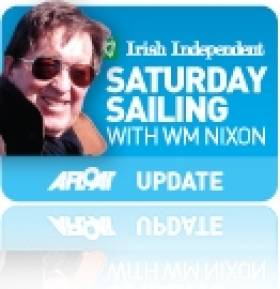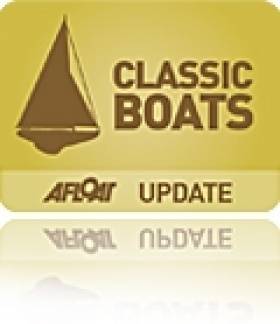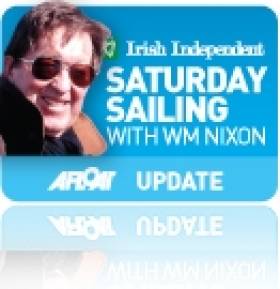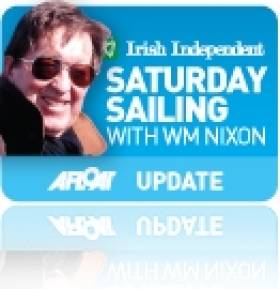Displaying items by tag: W M Nixon
Mirror Dinghy Worlds a Breath of Fresh Water Air From Lough Derg
#mirrorworlds2013 – For even the saltiest of seafarers, the Shannon One Design has a special allure. These slinky beauties of Ireland's inland waterways have an exotic attraction heightened by the fact that, despite their occasional visits to salt water, they only seem truly at home on the great lakes of the River Shannon. And when the organisers of the Mirror Worlds 2013 sounded out Simon Coveney, Minister for Agriculture, Food and The Marine, to perform last Sunday's official opening ceremony at Lough Derg YC at Dromineer, they discovered he was one of these secret Shannon OD admirers. Simon Coveney has raced offshore, and in major regattas. He has made oceanic voyages. And in his younger days, he was even an Irish Mirror Champion. But it seems the sweetener that drew him to Dromineer was the chance of his very first sail in a 17ft clinker-built Shannon One Design at one of their most historic strongholds.
So it says much about the sheer fun-filled exuberance of the great International Mirror Dinghy festival which concluded last night at Dromineer that for ten days - apart from Simon Coveney's sail with John and Adair Leech on their Shannon One Design - the SODs were sidelined. The characterful little Mirrors – 91 of them from seven diferent countries – totally dominated the scene both on the Dromineer waterfront, and out on the magnificent lake. And they had a tremendous week of racing despite a difficult period of weather in which four different seasons in one day – indeed, sometimes in one hour – set PRO Con Murphy a daunting task in which he completed a full programme despite Met Eireann outdoing itself in the gloomy weather prediction stakes throughout the week.
For those of us hoping to savour this remarkable event at its very best, it was a matter of Carpe Diem, Seize the Day, and the magic day was Tuesday. The morning may have seen the brisk westerly bring one large rainsquall blotting out the Clare hills as the fleet scampered along under spinnaker, but for the rest of the day the sun was strong from a vigorous sky. And the wind was brisk, then strong and then stronger again, such that by mid-afternoon further racing was curtailed. But by that time the legendary Mirror zest for sailing had been expressed yet again with gusto.
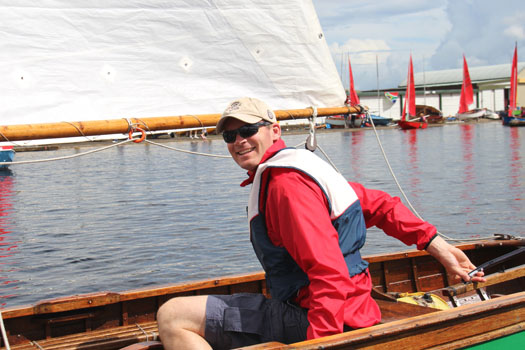
Minister for Agriculture, Food & The Marine Simon Coveney was able to fulfill a lifelong ambition to sail a Shannon One Design at Dromineer. Photo: Gerardine Wisdom
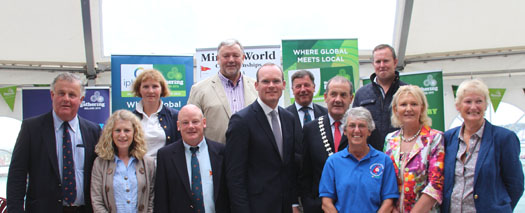
At the opening ceremony were (front row, left to right) David Meredith (Vice Commodore, LDYC), Cllr Virginia O'Dowd, Commodore LDYC Denis Hassey, Minister Simon Coveney, Mayor North Tipperary Ger Darcy, President Int. Mirror Association Celia May, Cllr Phil Bulger, and Assistant Event Manager Lucy Sanders. Back row: Event PR Eleanor Hooker, Noel Coonan TD, Event Manager Ian Roberts, and Cllr Seamus Morris. Photo: Gerardine Wisdom
In fact, the regatta was already in full swing by the time Minister Coveney performed his official duties, as the Irish Mirror National Opens had completed a successful if sometimes flukey four day eight-race buildup to the big one in the week beforehand, with a fleet of 68 boats getting results which were encouraging for visitors and the home fleet alike. And for anyone new to the Mirror scene, it gave a comprehensive insight into the variety of people these unique 10ft 10ins boat attract these days.
Clear overall winners were Ridgeley Balladares and Rommel Chaves of the Philippines with a convincing scoreline of five firsts and a fourth, discarding a 48th in Race 7 and a DNC in Race 8. If you think - like most folk in Ireland - that Mirrors are useful little multi-purpose boats for kids, then the Philippine pair were an eye-opener. Balladares is 36 while Chaves is 40, and the word was their day job is as crew on a superyacht whose owner encourages their dinghy racing. Naturally there were some muttering about this making them pros in a classically amateur class, but my own feeling was they deserved an extra medal – anyone who is keen enough to go off for some concentrated dinghy racing after the 24/7 grind which is being crew on a superyacht deserves special recognition.
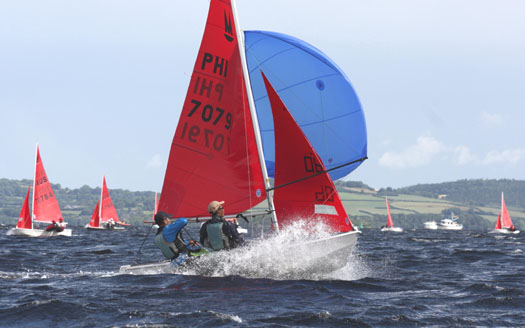
New Irish Open Champions Ridgeley Balladares and Rommel Cahvez of the Philippines were on top form in the opening four day event. Still on the windward leg astern are senior Australian helms Simon Barwood (46) no 70784, and Ken Barnes (61) no 70790. Photo: Gerardine Wisdom
The runners-up were Cian Hickey and Caolan Croasdell of Skerries, which doubtless caused dancing in the streets of Fingal. They finished on 25pts to the 9 of the Filipino crew, and four points ahead of Alfie Wisdom and Sam Warren of the host club, while in fourth and fifth came names which were to come to greater prominence in the Worlds proper, with British crew Sarah Richards and her son George one point behind on 30. On 36 points in fifth were South African siblings Ryan and Michaela Robinson of Boskop YC, poised (if they but knew it) to become International Mirror World Champions 2013, and leading a strong South African contingent in anticipation of the Worlds there in 2015.
The diversity of these crews is classic Mirror profile. Hickey and Croasdell are fairly standard at 18 and 14 years respectively, while Wisdom and Warren are 20 and 14. But a new profile emerges with the Richards duo – Sarah is 41 while son George is 12. And the promising South African brother and sister Robinson crew had one of the lowest average ages of all, with Ryan being 16 while Michaela is 13.
But if you think this diversity encompasses international Mirror sailing, think again. The first entry for the entire regatta came from Ken Barnes of Montrose Bay in Australia, and he's 61. Then from Canada came Donovan Alp, and he's 60. But all were put in the ha'penny place by Rex Henderson from Australia's Royal Freshwater Bay YC who admitted to being 70, but who knows, it might be more. So these crazy Mirror maniacs are the living embodiment of the ISA's motto of sailing being a sport for life. And as for running a successful World Championship being a matter of club and community endeavour, in a little place like Dromineer, it just has to be – it wouldn't work any other way.

An ideal venue – Lough Derg YC's current clubhouse was opened eight years ago. Photo: W M Nixon
Lough Derg YC (founded 1835) has an attractive, substantial and very efficient clubhouse which was opened after massive membership endeavour back in 2005, and deservedly saw LDYC taking the Mitsubishi Motors "Club of the Year" award. In effect, it functions as the lakeside village's community centre, and hosts such an extraordinary variety of events that in honour of one of them, the Dromineer Literary Festival, it was described this week as a Poetry Society with Sailing Club attached.
Just to show we're not making this up, this year's festival is from 3rd to 7th October, and all info is at www.dromineerliteraryfestival.ie. But meanwhile there was this business of the club taking on the biennial Mirror Worlds at a time when Mirror Dinghies are supposed to be rather passé despite their Golden Jubilee this year, and with the reality of Ireland being in recession and Dromineer being a place of limited visitor accommodation. In fact, it was the perfect formula to spur everyone on to greater effort. Just about everyone got involved, and the visitors from far and wide who couldn't find accommodation either in b&bs or people's houses found that there were berths available on the large variety of cruisers in the harbour.
So the people were indeed coming to Dromineer, and keen to race. A fleet of 91 boats isn't one to be sniffed at, and when you take on the mantle of a World Championship, you have the additional task of hosting teams of mandatory officials who have been guaranteed a certain level of comfort. It's a formidable organizational effort, but for a very long time in advance, Event Manager Ian Roberts and his Assistant Manager Lucy Sanders were putting their team together, and anyone who has been following the daily up-dates on Afloat.ie from Dromineer on the progress of the regatta will know that the sailors have been having a mighty fine time.
Even the daily reports have been a good example of team effort by the shore squad in the clubhouse and Mirror supporters out on the water. From the race course, Andy Johnston of Sutton Dinghy Club was filing in a stream of regular reports on tactical developments in each race, with additional input from Brian Raftery of Sligo. Back in the clubhouse, LDYC Press Officer Eleanor Hooker kept tabs on the reports she collated a daily report each evening which gave an excellent overview of the progress of a world class World Championship.
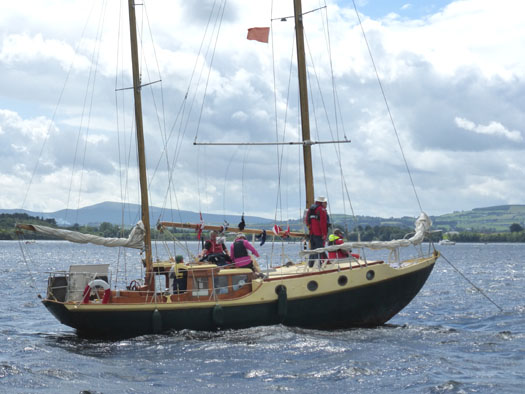
The hefty 1958-built steel ketch Shindilla proved an ideal committee boat, but even she showed that Lough Derg can make waves. Photo: W M Nixon
Out on the water, PRO Con Murphy and his crew were based on the Levie family of Clonmel's substantial steel ketch Shindilla. Originally built in the Netherlands in 1958 for Bob Berridge of Galway and Cork, the 38ft Shindilla is the ideal size for a committee boat on Lough Derg, as she's not too large, yet her weight provides a solid platform on a bit of water which can sometimes serve up rollers which wouldn't shame the sea.

The first race on the second day in the Worlds showed the Robinsons' winning style. The fleet shapes up with the port end suddenly becoming the favoured position...... Photo: W M Nixon
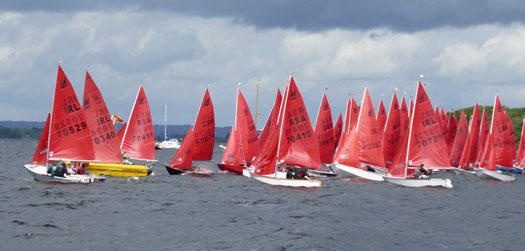
.....but two Irish boats (Keri-Ann Boylan & Ros Morgan, and Ronan Gilmartin & Sean O'Leary) find themselves pushed beyond the limit, yet the Robinsons zap away in perfect style clear on port such that.........Photo: W M Nixon

.....one minute after the start they're totally out on their own, sailing in clear air. Photo: W M Nixon
So the scene was set, with the community in the attractive village – on a good day it's the Tipperary Riviera - and the members in the bustling clubhouse all together on message. And there, wonderful as ever, was the lake, ready for it and astonishingly beautiful as only Lough Derg can be, particularly in a week when the changeable weather gave it a new brightness of sunlight and a welcome freshness after the choking and often windless heat of most of July. For although the Irish championship which started the regatta had occasional lack of wind pressure, for the Worlds it was a dream scenario with sailing at its best.
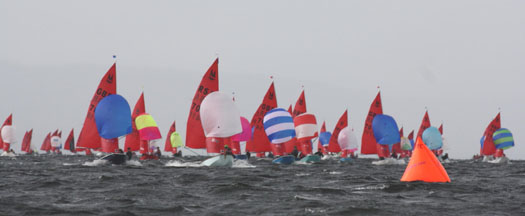
A rainsquall sweeps across, blotting out the Clare Hills, but on the run the Robinsons have reinforced their lead. Photo: Gerardine Wisdom
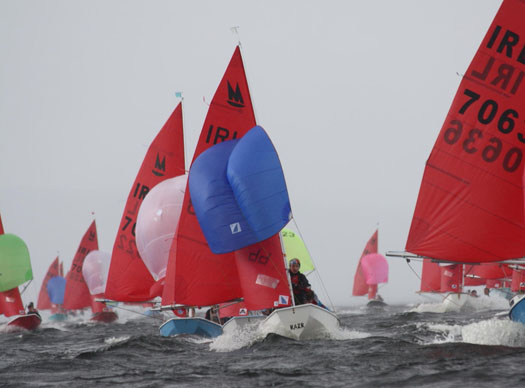
In the thick of it, running before Thursday's squall, are Tiarnan Dickson & Alex Leech (Lough Ree YC, white spinnaker), Jack Maye & Sarah White (Sligo YC, blue spinnaker), and Jack Ryan & Ben Graf (70636, Lough Ree YC). Photo: Gerardine Wisdom.
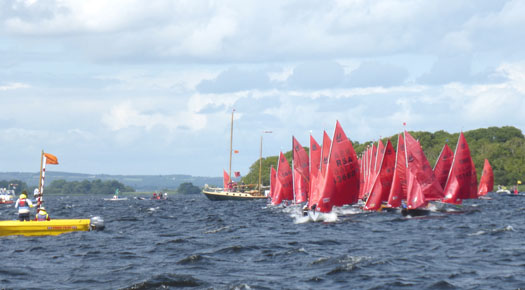
Second start on Day 2, and some folk think the port end is still favoured.......... Photo: W M Nixon
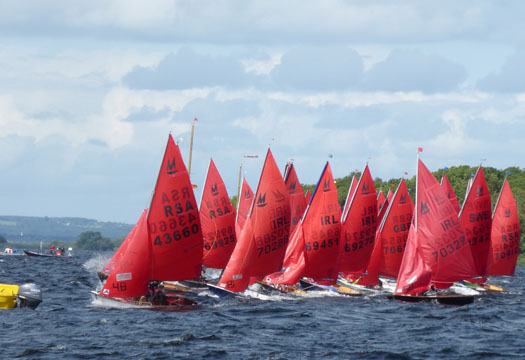
....but it isn't. Joshua Muller & Daniel Coetzer of South Africa hit it on the gun travelling well.........Photo: W M Nixon
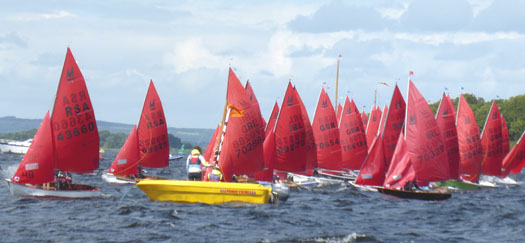
......and at first things are looking good for Muller and Coetzer. Photo: W M Nixon

Close behind, there's a merry bunch, with Emilio Williams Doran & Michaal Broaders (70288) put astray by a starboard rush. Photo: W M Nixon

Reality has intervened for Muller & Coetzer as boats stategically better placed at the start take over their apparent lead - in this case it's Jeremy and Lauren Stephens doing the business. Photo: W M Nixon

The fleet came from seven nations, and here Eoin Hickey & Sadbh Culleton of Ireland lead from Viktor Hogbom & Malin Goransson of Sweden and Howard Leoto & Pakamani Yoko of South Africa. Photo: W M Nixon
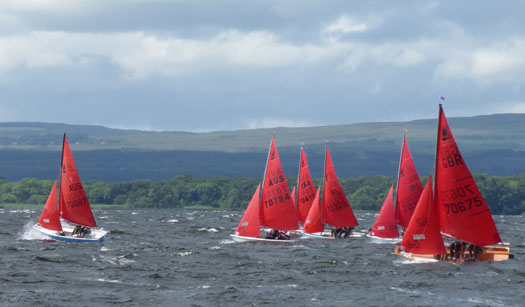
An Irish sailing memory to cherish – Lough Derg at its most handsome as David & Timothy Pilbeam (Australia), lead from Simon & Sidonia Barwood (Australia), Mark & Duncan Hawksworth (South Africa), George O'Connor & Aaron Rogers (Ireland), Robert Blake & Jack Fahey (Ireland), and Ben & Gabe Hill (GB).
Photo: W M Nixon
Seize the day, seize the moment – this was all very special. My own observation point was from Reggie Goodbody's gaff sloop Amaryllis, which is yet another Lough Derg curiosity, as her hull was built in Italy, then the boat was finished in Holland. But now she is such a ubiquitous feature of all Ireland's inland waterways that she's believed to be the only boat which has crossed the M50 under sail – she did it on the Royal Canal aqueduct.

The only boat ever to cross Dublin's M50 under sail – Reggie Goodbody's Amaryllis in her home port of Dromineer. Photo: W M Nixon
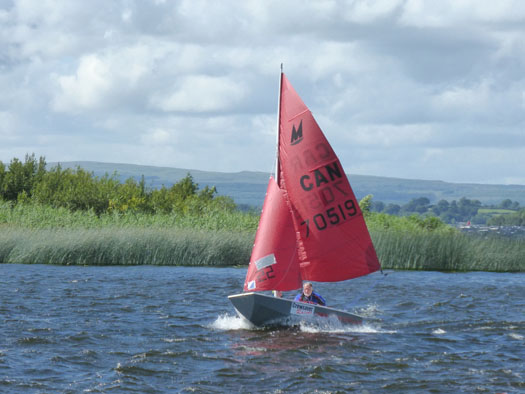
Calling it a day. Senior Canadian crew Donovan Alp and Daniel Coady return to Dromineer.......Photo: W M Nixon
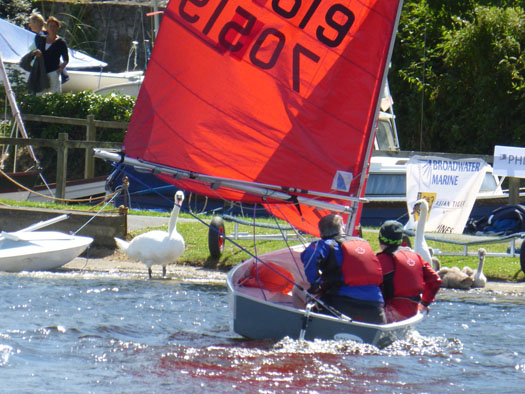
.....only to find that their allocated berth has been taken over by a family of swans.......Photo: W M Nixon
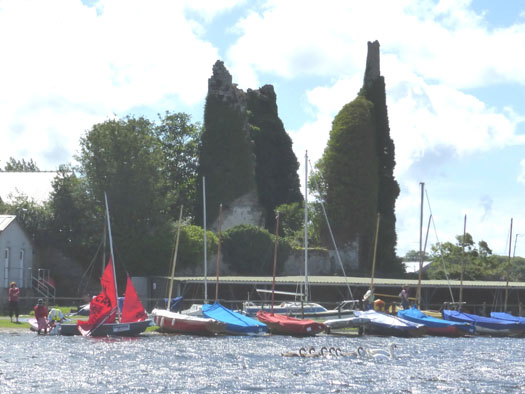
....but Canadians are good at peace-making and the swans move on......Photo: W M Nixon
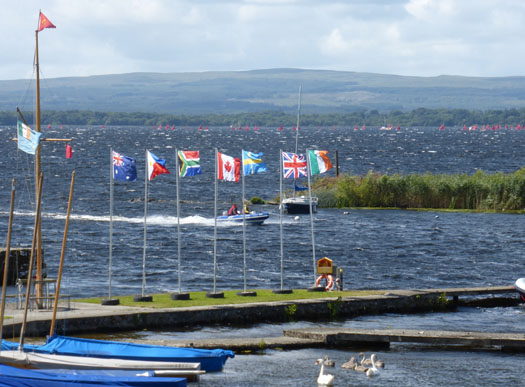
....to a more appropriate berth beside the Shannon ODs, while out on the lake, racing has finished for the day as the wind freshens still further. Photo: W M Nixon
Amaryllis's hefty nature meant we couldn't mix it in the heat of the fleet with the proper photographers' RIBs, but we got the flavour of it, and more particularly we were comfortably back in time for the post-sailing atmosphere in Dromineer. Thus we saw senior crew Donovan Alp and Daniel Coady from Canada making their early return to find a very strong looking family of swans had taken up residence on the Canadian's allocated berth. Somehow, it was sorted out (Canadians are good at peace-making), and the swans re-located to a suitable spot beside the Shannon One Designs. while out on the lake the day's racing was signalled as over, and the fleet cascaded back to shore.
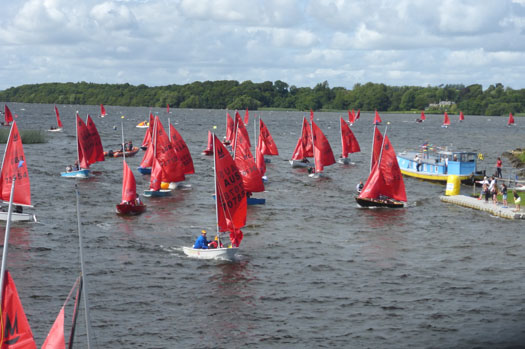
Mirrors everywhere as the fleet cascades back into port. Photo: W M Nixon
By this time, I was so Mirror mesmerized that I'd got to the stage of thinking any boat with a pointy bow and white sails was an oddity. Normality had become a boat with a bluff little hull and red sails, sailed by people who race for fun. And Dromineer is the ideal spot for them. After racing at a saltwater venue, you have all the hassle of washing down boat, gear, sails and crew with fresh water. But that simply doesn't come up on the agenda in Dromineer. It's a sweet spot.
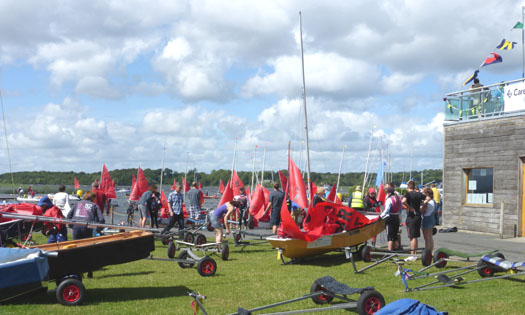
Post race Dromineer. At the end of the day, there's no tedious requirement for washing off the salt. Photo: W M Nixon
And Now, It's The New Dublin Bay 21...
#first21 – It's all so very 21st Century. The growth and development of this new Dublin Bay One Design has been healthily organic. And it hasn't been imposed from above – there's none of your old-fashioned de haut en bas here. Nor has it been dreamt up in some winter committee meeting by people with more notions than practical experience. On the contrary, it has developed at grass roots level, out of a genuine need, in an impeccably people-friendly way. And perhaps best of all, it involves a high level of re-cycling. For although this "new" boat perfectly fits the contemporary Irish sailing zeitgeist, the design has been around for 20 years. So making a new class out of it simply involves fulfilling the true potential of attractive little boats which have been just waiting to blossom since 1993.
Not that the First 211 was ignored when she made her debut back in the day. I can recall being utterly charmed aboard an early version in a Dublin Boat Show (remember them?) a long time ago. We old salts were particularly taken with the cute little porthole in the topsides, like a traditional little Edwardian cruising cutter, all made more charming by knowing the boat was designed by Groupe Finot and had drawn on the experience gained with Figaro Solo boats and Open 60s in order to produce a compact trailerable family cruiser with attitude.
But at the time the little boat made her debut, the Celtic Tiger was starting to flex his muscles. So the small-scale charms of the First 211 were overlooked in a mad rush for size and shine. Not that you couldn't get a deep shine on the boat's quality Beneteau hull, but you know what I mean. Yet for people with a particular set of sailing needs, the design has always neatly met their requirements, and today in its various forms, it is fulfilling many roles, including being the newest one design class in Dublin Bay.
It has come together in a diffident sort of way, and though they've had racing in the bay as a class for a year or so, next month's Volvo Dun Laoghaire Regatta will mark their debut as an official class on the national scene. There are 14 entries, made up mostly of local boats, but with a couple coming from the thriving class on Lake Windermere, plus another from Tralee Bay And there's one gallant boat from north of the Liffey, Brian Stewart's Mon Reve based at Malahide, where a summer evening's club race this week provided the opportunity to taste and test what is shaping up to be the new Dublin Bay 21.
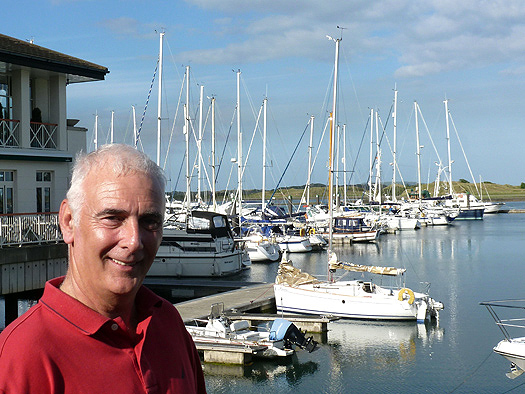
Happy man. Brian Stewart on a perfect summer evening in Malahide with his First 21 Mon Reve, and some good club racing in prospect.
Photo: W M Nixon
The designs of Jean Marie Finot first came to prominence in the late 1960s when he won the Quarter Ton Worlds with a boat which went on to become the 26ft Ecume de Mer in the production version. The Ecumes defined the early Finot style, and they're a super little boat, well worth restoring if you happen to come across one needing TLC. Admittedly some minor flaws may have appeared over time, but they're all eminently fixable.
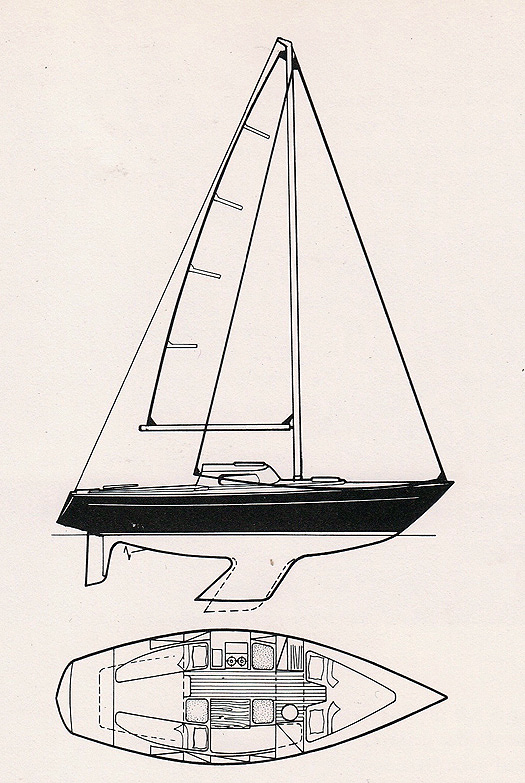
The 26ft Ecume de Mer of 1969 was hugely successful in launching Jean Marie Finot's international design career. And she really could sleep five adults in port.
Back in those days, the Sisk family of Dublin had a very successful Sparkman & Stephens 36ft sloop, Sarnia, an Italian-built version of the Swan 36 – she's still in Dun Laoghaire, and had a fine restoration job done a few years ago. But in 1969 Hal Sisk happened to see one of the earliest Ecumes de Mer at the Genoa Boat Show, and he also met up with Finot. Somehow he persuaded the rest of the family that they should have a very special 30ft aluminium offshore racer to the latest Finot designs to take every possible advantage of the new International Offshore Rule.
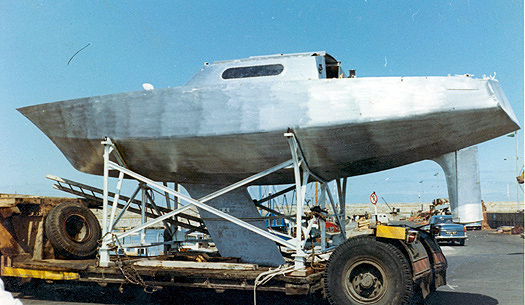
"Naked as a jaybird". The 30ft Finot-designed Alouette de Mer was totally unpainted when she arrived in Dun Laoghaire by road in July 1971 – and she stayed that way for her first season. Photo: Hal Sisk
Alouette de Mer was built in a factory near Le Bourget airport in Paris, and arrived in Ireland ready for sea in every way except that she was totally unpainted. The Sisks had been persuaded with irrefutable French logic that it wasn't necessary, so she went newly afloat in July 1971 naked as a jaybird, and won her first race, and many thereafter. I can remember racing against her that year, but it wasn't until a late July evening when were sailing gently through the moorings in Dun Laoghaire, and saw Alouette de Mer on her moorings among more traditional boats, that the utter starkness of her appearance really registered.
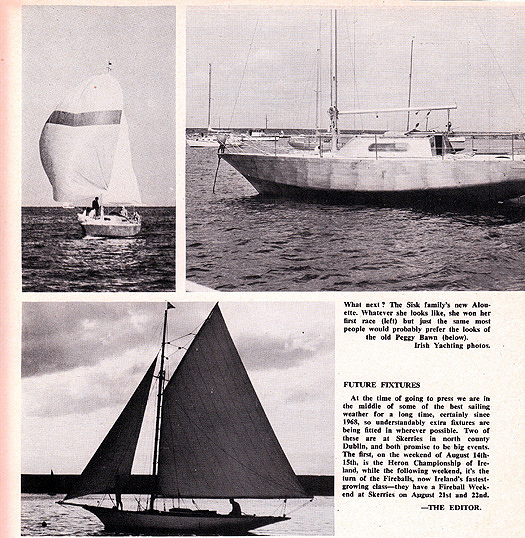
Spooky prescience - section of a page of the Seascape column in Irish Yachting & Motorboating, August 1971.
Nearby, Dun Laoghaire's most senior skipper James McAsey was quietly gliding along in his 1894-built gaff cutter Peggy Bawn, which he'd owned since 1919. It may well have been his last season sailing her. But many years were to elapse before Hal Sisk rescued Peggy Bawn from mummification to become a star of the international classic yacht circuit. At the time, Afloat magazine was known as Irish Yachting & Motorboating, and in the August 1971 issue, in a general column called Seascape, we published photos of the two boats and contrasted them. It certainly was some sort of weird prescience, even a bit spooky.
Subsequently, Alouette was painted red, but it didn't stop her winning. Though she wasn't the prettiest girl on the block, she was remarkably comfortable to be aboard, particularly in the cockpit - a Finot characteristic also found in the Ecume de Mer. Alouette personified racing enthusiasm, so when the Sisks decided that they had done enough for the cutting edge, and moved to the more traditional elegance of the 43ft Standfast designed by Frans Maas, Alouette went to Cork and the ownership of Hugh Coveney, who'd a great time sailing her with Harry Cudmore, before they in turn moved on to the new Ron Holland One Tonner Golden Apple.

In those days, genoas were ENORMOUS – Alouette de Mer going well in her second season in Sisk ownership. The cockpit was notably comfortable. Photo courtesy Hal Sisk
The next Finot design to make any significant impact in Ireland was the Fastnet 34 built in Limerick, probably the roomiest performance 34-footer ever built. You'll still see them around – Derek and Viv White's 1976-built Ballyclaire in Strangford Creek is a well-loved example. But with French sailing becoming turbo-powered by the 1980s, the Finot design office moved on from being a one man band to become a substantial organization, Groupe Finot, and their work expanded into some very big racing machines. Yet they still could produce very sensible smaller boats when asked, and the First 25 of the mid-1980s is an excellent example.
So when the Beneteau organization focussed its attention on a new trailer sailer for the early 1990s, it was to Groupe Finot that they turned for innovation and fresh thinking generally. You get an impressive package with the First 21. She has twin rudders, which makes a lot of sense for ease of steering in any beamy boat with the beam carried well aft. But in this case there's a bonus, for when the lifting keel is raised the depth of the rudders is such that the boat stands upright, supported by the rudders.

The plans of the First 21 show an effective rig, while the twin rudders keep the boat upright when dried out on the raised keel.

The accommodation packs in as much as possible in a performance 21-footer.
For most sailors, twin rudders and a lifting keel provide enough innovation to be going along with, so when I joined Brian and his crew of Kieran the tactician and Zenda the trimmer and Derek the bowman on an evening when Malahide was like San Diego only better, the workings of these features was of prime interest.
The keel stays down permanently. It's held down by a strut which will give way if you biff a rock, but is vastly superior to having a weighted centreboard which solely relies on gravity to stay down. Replacing the strut mechanism is not cheap if you indulge in impactive pilotage, but it's much less costly than major hull repairs at the upper aft end of the keel.

The keel is raised by 57 turns of a winch handle inserted in the socket at the top of the keel housing. Photo: W M Nixon
The keel is raised by 57 turns of a winch handle, so if the significant other in your life happens to acquire a First 21, you can get him or her one of those battery powered winch handles as a Christmas present. It will only need to be re-charged once in the season, as the boat is effectively a keelboat when in commission. But particularly in the Dublin context of limited and expensive waterfront boat storage space, the First 21 has the very attractive option of end-of-season trailerability and ease of getting her home if you happen to have space there. Brian Stewart lives in Castleknock, and it's only a morning's work to get Mon Reve onto the trailer and back to the house for free winter storage.
As for broadening the scope of sailing, Ireland's improved roads have brought West Cork comfortably into his summer sailing plans. That said, the boat is only just over 21ft long, and while she has very comfortable sitting headroom and is well thought out within her size limitations, and can at a pinch sleep four, this really is a boat only for enthusiasts to cruise in liveaboard style, but if you limit yourself to day sailing in your chosen area, she does very well indeed for general use by varied levels of sailing interest.
Auxiliary power is provided by an outboard, and much as we all may dislike the look of an outboard hanging out of the stern of an otherwise attractive boat, you get used to it and it's very convenient. Plus when you're racing you only look astern if you're leading the fleet, which greatly offsets the outboard's jarring visual intrusion.
While the functional appeal of twin rudders is obvious, the fact that inter-connecting them to a single tiller involves several links inevitably causes a certain amount of play in the steering. That said, I'm told some of the Dun Laoghaire hotshots have already worked out ways of reducing this play to virtually nothing, but it requires perfect setting of the tracking.
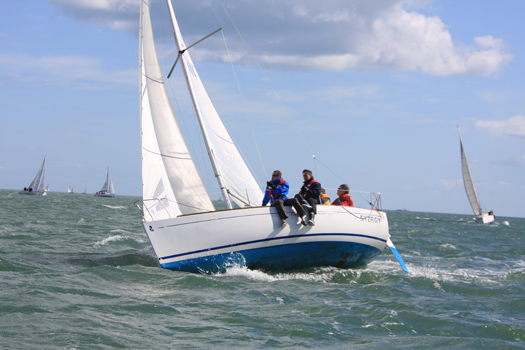
The development of the First 21 class in Dublin Bay has greatly increased the knowledge and skills to make these attractive little boats perform even better Photo: David O'Brien
Mon Reve sets a very nice set of threads made in Malahide by Philip Watson, and they did sterling service in a cruiser race in which the smallness of the fleet was more than offset by its variety. In a pleasant southeast breeze racing a windward-leeward, we were the smallest boat in conditions which were bound to suit the fastest, as the upwind leg was against the last of the flood, while the ebb was building as we ran back to the finish.
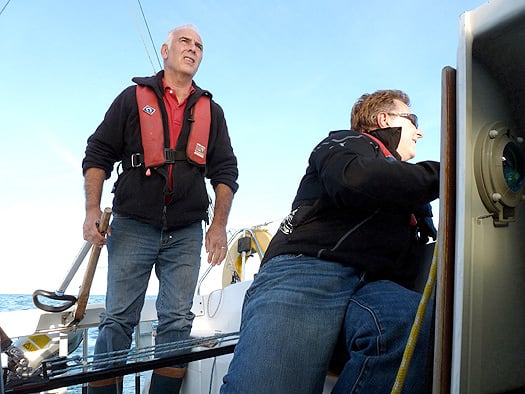
Brian and Kieran limbering up for the start Photo: W M Nixon
The enemy consisted of J/24, a Bolero 25, a Corby 25 and a Kelt 850. It makes you realize just how much of a compact cruiser a First 21 is when you realise these all seemed like big bullies. But Mon Reve punched above her weight. With Brian on the helm and Kieran calling the shots and keeping up a constant commentary on speed fluctuations, we gave it a good shot. As visiting ballast, I moved about the cabin sole, as it's crucial to trim to heel her such that you keep the lee rudder vertical at the very least, and ideally heeled a little. It was no hardship down below – you really can keep an eye on things through those ditzy little portholes in the hull topsides.
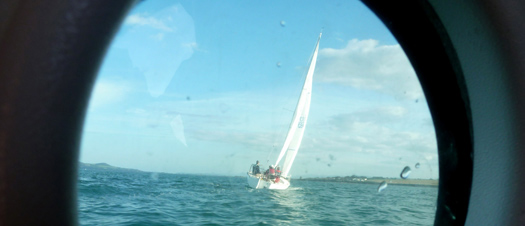
The enemy through the porthole – the J/24 eventually won. Photo: W M Nixon
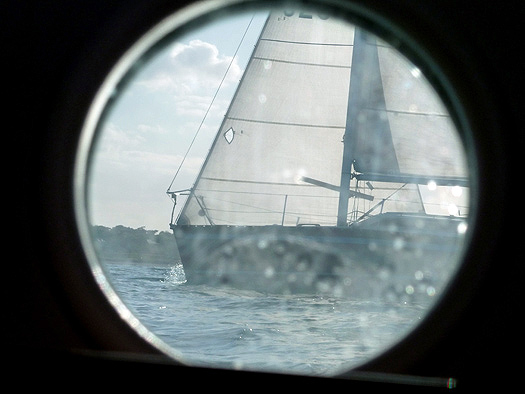
This was as near as the much larger Kelt 850 got to Mon Reve Photo: W M Nixon
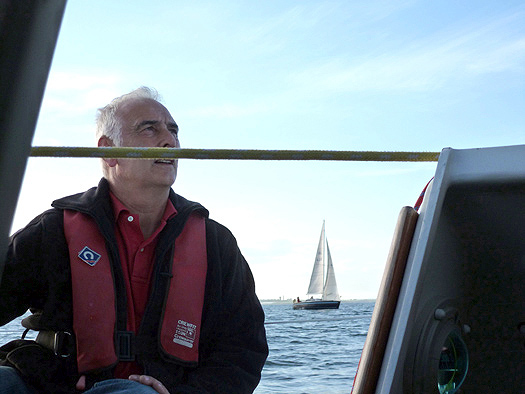
The skipper concentrates with the Kelt 850 nicely tucked away Photo: W M Nixon
We were fourth round the weather mark, having seen off the Kelt 850, and then things got exciting. Far from collapsing, the evening breeze kept up strength, sweet and warm. Up ahead, the Bolero 25, having sailed a blinder of a beat to lead at the weather mark, blew it all with eccentric spinnaker work and let the J/24 through. With the tide building against us, first to finish was going to win on handicap, and both the J/24 and the Bolero were to have us on handicap by a minute or two.
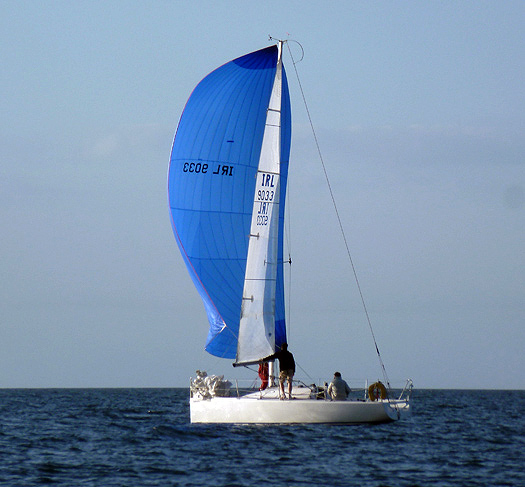
The Corby 25 had an idea about going off to starboard on the run, but it wasn't a winner and it brought Mon Reve into the hunt for a close finish. Photo: W M Nixon
But we'd a real tussle with the Corby 25. They went off on starboard gybe presumably to position themselves better across the increasing foul tide towards the finish line. But we found the groove on port, and made hay with a private air. If you look at the plans, you'll see the First 21 has quite a decently tall rig, and it worked a treat on Wednesday evening, with spinnaker and mainsail in harmony. The Corby finally got it together to scrape across ten seconds ahead, but Mon Reve was a very solid third on corrected time, and we'd had a lovely sail on an evening when no-one had expected the breeze to hold up.
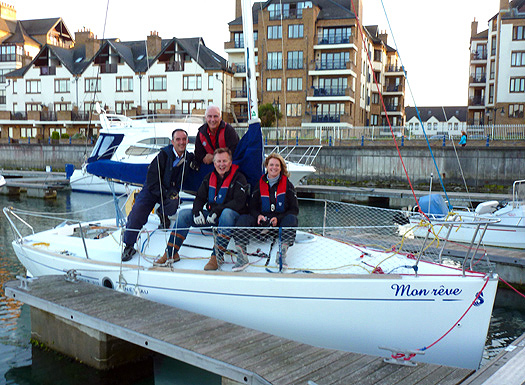
Happy boat, happy crew – Mon Reve back in her berth in Malahide Marina Photo: W M Nixon
So the First 21 is much more than just a clever trailer-sailer. She's a super little club racer, and she'll provide a fine one design class in Dublin Bay. And not just there, either. While Mon Reve and her friendly crew may have to go to Dun Laoghaire for a bit of level racing in a fortnight's time, it seems to me that Malahide would make the perfect centre for another nucleus of First 21s racing regularly as a class. They're one very likeable little boat, and Malahide needs a class like this.
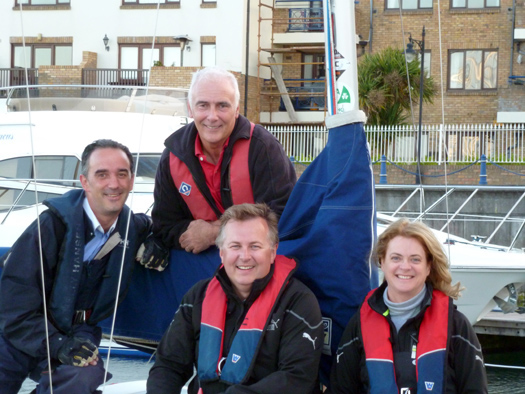
They're gearing up for the Volvo Dun Laoghaire Regatta's first series for the First 21 class – Mon Reve's keen crew are (left to right) Derek the bowman, Brian the VRO, Kieran the tactician, and Zenda the trimmer. Photo: W M Nixon
Beneteau is distributed in Ireland by BJ Marine Ltd
Comment on this story?
We'd really like to hear from you! Leave a message in the box below or email William Nixon directly on [email protected]
WM Nixon's Saturday Sailing blog appears every Saturday on Afloat.ie
Follow us on twitter @afloatmagazine and on our Afloat facebook page
Good Old Gaffers in Dublin Bay
#oga50 – It's not the boats that are the marina manager's nightmare. It's the bowsprits. That said, the boats themselves, with their long old keels and huge propellor apertures, or even with funny little props set under the quarter – these boats can be problematic. With configurations like this, you can bet for sure they can be awkward enough to manoeuvre. And handling them in confined spaces, you need a masters degree in prop crawl.
Yet that is still something to which normal boaties can relate. But then you throw in a bowsprit as big as a telegraph pole, pointing into everywhere it isn't wanted like a snouty mongrel, then you really do have a problem in a confined harbour normally used by shiny little boats that can spin in their own length, and stop within seconds of engaging in astern.
All of which goes to explain why the Old Gaffers Association, celebrating its Golden Jubilee with a Round Britain challenge with a couple of diversions to Ireland, has tended to focus on major ports with long pontoons and longer quays for its main gatherings. In Britain the festivities are sponsored by Associated British Ports, while in Ireland it has been Dublin Port and Belfast Harbour who have put out the welcome mats. So the fleet came to Dublin Bay from May 31st to June 4th to be hosted by the Dublin Bay Old Gaffers Associations through the generous hospitality of Poolbeg Yacht & Boat Club, and Dublin Port gave it all a fine fair wind.
The Old Gaffers Association was founded at Heybridge Basin beside the characterful little port of Maldon in Essex in 1963 to "preserve interest in, and encourage development of Gaff Rig, and to participate in the maintenance of our maritime heritage". Over the years, as some good Bermudan rig boats have matured, the gaff-rig-only line has been softened to include them, and the membership now even includes people with plastic boats.
The Golden Jubilee cruise – a season-long rolling event, with boats joining and leaving as they please - got under way from Maldon on April 21st 2013 in a very modest sort of way with just three boats initially participating, and only two of them – the 1898-built 31ft cutter Witch (Alistair Randall, originally built as the ferry to Gigha in Scotland) and the ferro-cement gaff-rigged take on a John Hannah design of 1924, the 37ft Bonify (Sue Lewis & Howard Wheelton) – planning to go the whole way round.

Bonify (red hull) is one of the two boats which started the complete circuit from Essex rolling on April 21st. She is seen here at Poolbeg Y & BC as the Howth 17s start to arrive in port on Saturday June 1st. Photo: W M Nixon
But in their charm and individuality, Witch and Bonify symbolize the eclectic nature of the Old Gaffers Association, which cheerfully embraces all the odd old boats and eccentric owners that other organisations don't reach. And in their progress round the southeast of England, they were soon linking up with a a strong Dutch contingent which included craft as diverse as Rik Janssen's mighty Galway Hooker Cine Mara (superbly built in steel) and F J Schotman's exquisite little Lyle Hess-designed 28-footer Raven.
Gradually the fleet increased as the OGA50 made its way down the English Channel. But the vile weather of May hampered their progress, and few made it to a planned meet in the Isles of Scilly. However, despite headwinds a core group got round Land's End and across to Milford Haven, their numbers by now including 73-year-old Barbara Runnalls from Sussex gallantly sailing alone on the 23ft gaff cutter Moon River.
After days of adverse northerly gales in Milford Haven, the end of May finally signalled the start of something approaching summer, and they went north to Holyhead and a warm welcome from the local branch of the OGA. There too was Joe Pennington who had earlier sailed down from the Isle of Man singlehanded in his handsome big traditional cutter Master Frank, the only surviving Manx longline sailing fishing boat. On being congratulated on his achievement, Joe replied that when you've a Force 8 up your tail, there's no turning back...
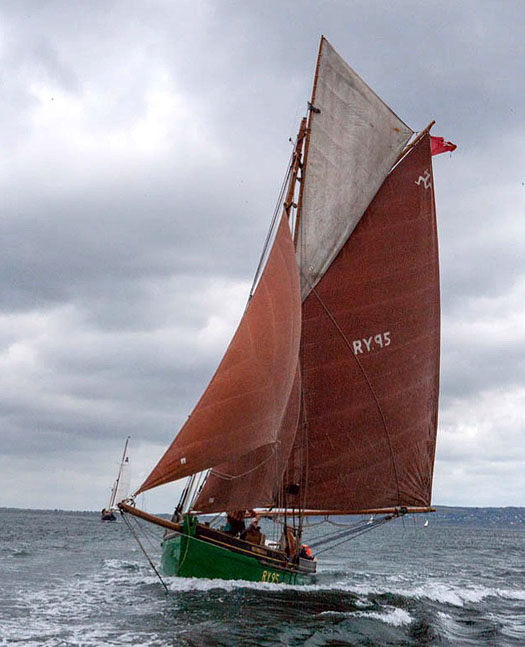
The Manx fishing boat Master Frank was sailed single-handed by Joe Pennington from Peel to Holyhead in a northerly gale to join the OGA50 Photo: Barry O'Loughlin
Through the last week of May, boats were converging on Dublin Bay from all corners of the Irish Sea, and in Howth the 115-year old classics of the Howth 17 class were in a flurry of activity to overcome the delays in re-fitting caused by the exceptionally cold Spring, as they were to race in the River Liffey between the bridges in the heart of Dublin on Sunday June 2nd as part of the maritime festival which would be a highlight of the OGA's visit.
The Howth fleet were joined on Thursday May 30th by the 36ft 1912-built yawl Ainmara (Dickie Gomes, Strangford Lough) which had scampered down from Strangford in a nor'wester which, downwind of the Mountains of Mourne, had been at the top end of Force 7. The old lady was on a busy programme, as she was designed and built by the great John B Kearney at Ringsnend in Dublin in 1912, and would be re-visiting her birthplace of 101 years ago for the first time in 90 years.
But during the time John Kearney owned her from 1912 to 1923, Ainmara had been overall winner of Howth's famous annual Lambay Race in 1921, so this had to be celebrated at Howth Yacht Club with an onboard party which had the old yawl well down on her marks. By the time it was over, Dickie Gomes had been assured by the Flag Officers that if he could see his way to staying on for this year's Lambay Race (it's on today), then HYC would make sure Ainmara won it again. But alas, as Ainmara was built in the same year as the Titanic but has survived rather better, this weekend she's berthed in Belfast at the Titanic Centre to play a central role in the OGA's visit to the northern port.

The 101 year old Ainmara in Howth on May 30th to recall her overall win in the 1921 Lambay Race Photo: W M Nixon
Meanwhile, back around Dublin Bay, she still wasn't allowed to go straight home to Ringsend, as John Kearney's latter days from 1946 to 1967 saw him as an honoured Rear Commodore of the National YC in Dun Laoghaire. So on Friday May 31st under full sail to jib topsail, she progressed across Dublin Bay helmed by Pierce Purcell of Galway, whose late father was Commodore of the National YC from 1946 to 1948, when he owned the very attractive 35ft Kearney yawl Sonia.
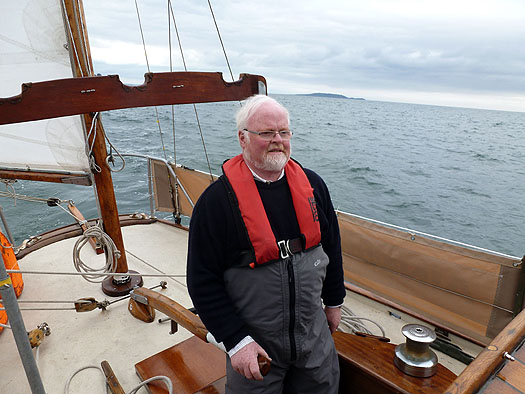
Pierce Purcell of Galway at Ainmara's helm in Dublin Bay – he crossed Ireland for the opportunity to sail a Kearney boat like his father used to own. Photo: W M Nixon
Sonia is now in Canada, but helming Ainmara across Dublin Bay was the next best thing. The Galway man brought Ainmara to the Dun Laoghaire harbourmouth nicely on time to be met by two of the Dublin Bay Mermaids (designed by John Kearney in 1932), which escorted the old yawl to the visitors berth at the National YC where Commodore Paul Barrington headed up his members in a welcome which was superb even by the National's notably high standards, with the club flagpole dressed overall and the signal JBK on the staff.
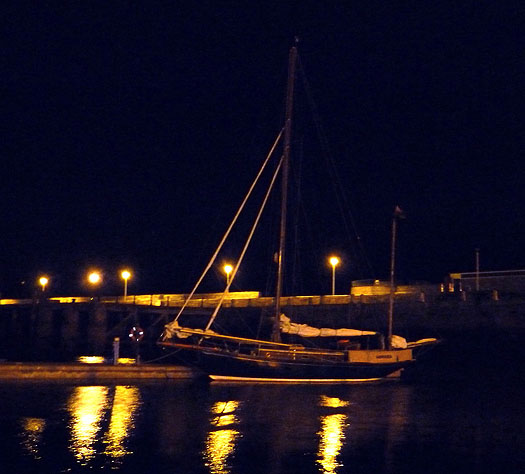
"The old lady is ready to race". Ainmara poised at the pontoon at the National while her welcome party proceeds apace in the clubhouse. Photo: W M Nixon
The first sailing highpoint in the OGA visit to Dublin was to be a race on Saturday June 1st for the RMS Leinster Plate, newly presented by the Communication Workers Union to honour all those who were lost when the mailboat Leinster was sunk by German torpedoes at the Kish Lighthouse in the final months of World War I, and in particular the 21 postal workers who died in the ship's mail sorting room. The plan was to have a race which would retrace at least part of the Leinster's fateful route towards the Kish from Dun Laoghaire, but Race Officer John Alvey of Poolbeg Y & BC couldn't finalise the course for guaranteed finish at a reasonable time in mid-afternoon until early Saturday morning.
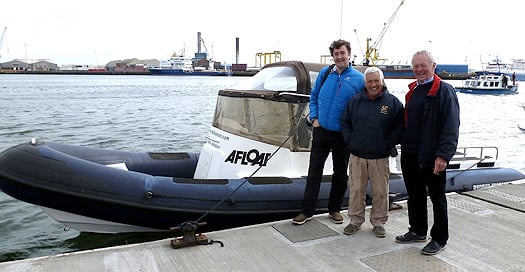
It's the only way to fly. Afloat's David O'Brien with Dickie Gomes and crewman Brian Law after he'd conveyed them at record speed to the early morning Skippers' Briefing at Poolbeg Y & BC Photo: W M Nixon
So the Skippers' Briefing was at Poolbeg at 0800 hrs, with race start scheduled for Scotsmans Bay at 1100. This could have presented a logistics problem for Ainmara's crew already berthed in Dun Laoghaire, but fortunately nice Mr O'Brien from Afloat.ie turned up in the early morning with his fine Red Bay RIB, and they were delivered to the briefing and back again at speeds well north of 30 knots, also enjoying the first of many fine breakfasts supplied by Kate and her excellent catering team at Poolbeg.

DBOGA Hon. Sec. Sean Walsh's heard 28 Tir na nOg had a good weekend of it, with a third on the Saturday and a first on Monday. Photo: Barry O'Loughlin
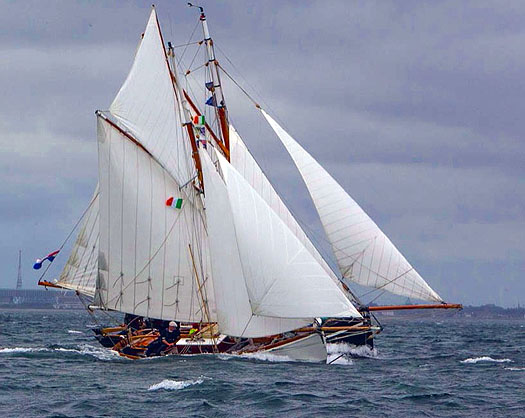
The Lyle Hess 28 Raven from The Netherlands had a fine race on Saturday, finishing second overall. Photo: Barry O'Loughlin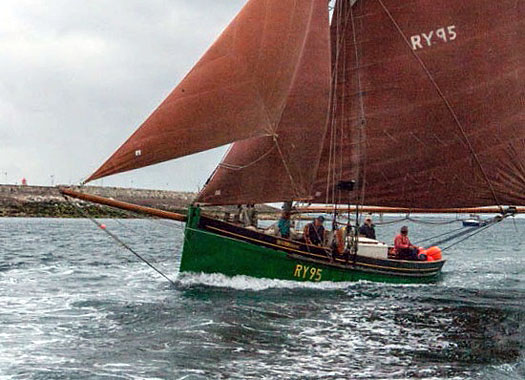
Master Frank (Joe Pennington) was to lead at the North Burford Photo: Barry O'Loughlin
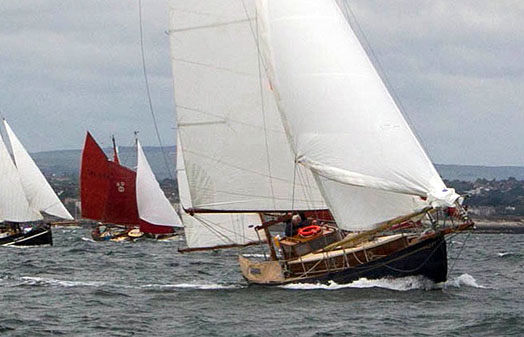
Ainmara starting to emerge from the pack Photo: Barry O'Loughlin
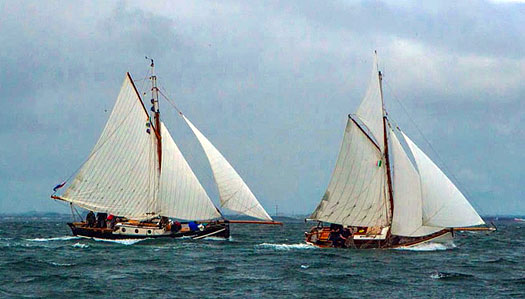
Dutch competition – the little Raven shows the big Cine Mara the way Photo: Barry O'Loughlin
As the forecast was for the brisk west wind to go light by mid-afternoon, the course went no further seaward than the North Burford Buoy. The reaching start was lively with some very long bowsprits pointing every which way and travelling at high speed, but everyone emerged still more or less intact and at the North Burford Joe Pennington's mighty Master Frank – her crew including longtime Galway Hooker/Arctic hand Paddy Barry – was in the lead. But Ainmara, having got herself into the hunt by sending up her jib topsail as the breeze eased, was settling into the groove and revelling in conditions that might have been made for her. She was clear ahead by the next turn at the Rosbeg East, and though the final leg from Rosbeg South to a finish at Drumleck was tricky as the tide was by now sluicing eastward across it to make it a challenging beat. But thanks to the party in the National YC the night before, Ainmara had Mermaid National Champion Jonathan O'Rourke as guest helm. He sailed the old Kearney yawl so well she had a very clear handicap win after taking line honours by a country mile.

Sean Walsh's Tir na nOg and Paul Holden's Chick Pea battling it out. Photo: Barry O'Loughlin
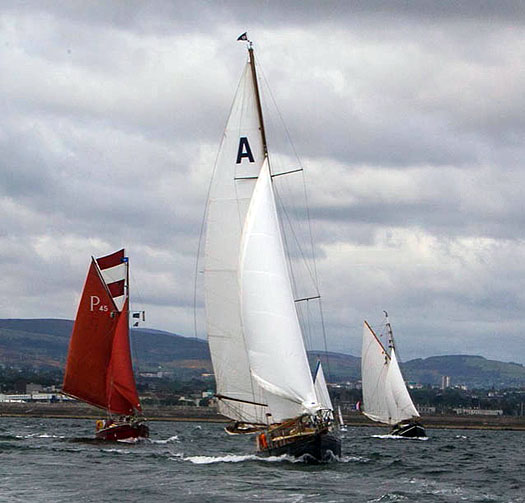
Ainmara getting into her stride. Soon afterwards she hoisted her jib topsail, and was gone Photo: Barry O'Loughlin
While DBOGA Honorary Secretary Sean Walsh had a cracker of a race with his Heard 28 Tir na nOg, his crew including OGA National President Mike Shaw, when the numbers were crunched it was the lovely little Raven from Makkum in The Netherlands which took second, with Tir na nOg third. The top ten corrected time placings for the Leinster Plate give a useful overview of the widespread nature of the OGA Fleet:
Leinster Plate 2013 1st Ainmara (36ft yawl 1912, Richard Gomes, Strangford Lough) 01:45:39, 2nd Raven (Hess 28, F J Schotmann, Makkum, Netherlands) 01:54:26; 3rd Tir na nOg (Heard 28, Sean Walsh, Poolbeg) 01:55:56; 4th Verve (37ft Arthur Robb yawl, 1964, Brian Comerford, Dun Laoghaire) 02:07:15; 5th Master Frank (Manx Longliner, 1896, Joe Pennington, Isle of Man) 02:13:13; 6th Mona (Cornish Crabber, Denis Aylmer, Dun Laoghaire) 02:27:17; 7th High Barbaree (34ft Cornish Pilot Cutter, Tim & Liz Dodwell, Buckler's Hard, Hampshire, England) 02:27:46; 8th Chickpea (30ft Victorian cutter, Paul Holden, Howth) 02:28:39; 9th Cine Mara (42ft Galway Hooker, Rik Janssen, Schermer, Netherlands) 02:54:59; 10th Alice (Cornish Crabber, Mark Lynch, Howth) 02:56:59.
As the main fleet were finishing in the Leinster Plate, the Howth 17s were already making their way into Dublin Bay on their delivery race from Howth. In fact, two had arrived well in advance of the rest. These were Harriette Lynch's Echo and Ian Malcolm's Aura, which had come round to Dublin Bay hoping to do the Leinster Plate race. But having been late for the start, they strung along with the fleet nevertheless, and then when their doughty skippers and crews saw that the fleet clearly weren't going round the Kish as had been suggested months ago, they simply sailed their little boats out to the lonely lighthouse on their own, and having sailed round (it's in fine order, but smelling mightily of unconstipated seabirds) they sailed back again in plenty of time – despite a two-and-a-half hour beat in from the Kish - to join the party at Poolbeg. seabirds) they sailed back again in plenty of time to join the party at Poolbeg.
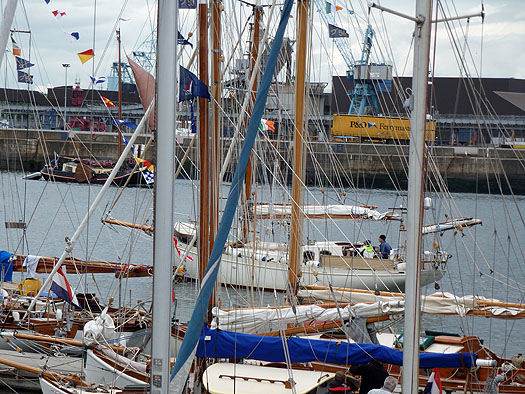
The successful circumnavigator of North America, Andrew Wilkes and Maire Breathnach's 44ft steel-built gaff yawl Young Larry, comes into Poolbeg to join the party. Photo: W M Nixon
And what a party it was, rounded out by the presentation of the Leinster Salver to Dickie Gomes of Ainmara. Most of the Old Gaffers, having sailed so far to get to Dublin Bay, had never intended to go straight out again for a race. So for those of us arriving in late on Saturday afternoon to join the fleet for the first time, the effect of the crazy kaleidoscope of boats – everything from Rachel Leech's 64ft Tjalk Ebenhaezer brought across Ireland via the Grand Canal from Athlone, right down to the 12ft Droleen dinghy from Bray – was electric.

Here they come – the first of the Howth 17s arrive at Poolbeg after a race fom their home port had ended in a dead heat between three boats. Photo: W M Nixon
And then the main fleet of the Howth 17s arrived, tacking up the river with jackyard topsails set. Somebody should have put up a trophy for their delivery race from Howth to the entrance to Dublin Port, for it was an epic sail in itself, much of it against the tide. With the distance to be sailed, it was assumed that a clear leader would have emerged by the time they reached the finish, so they had no-one at the end of the Bull Wall to time them in. It says everything about the spirit of the class that the three leaders were so close coming into the river that the Howth 17 Howth-Poolbeg Race 2013 has been declared a dead heat between Deilginis (Massey syndicate), Oona (Peter Courtney), and Rita (John Curley & Marcus Lynch).
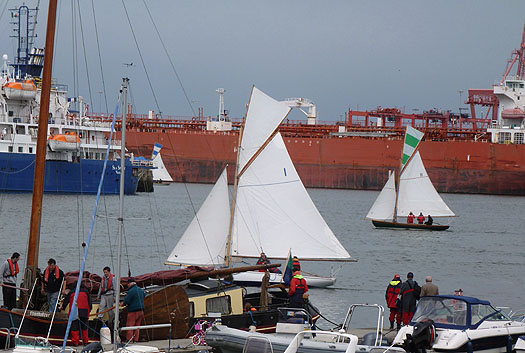
Rita (1) and Deilginis (11) dead heated at the finish of Saturday's race from Howth, and they each won a race on Sunday.
Photo: W M Nixon
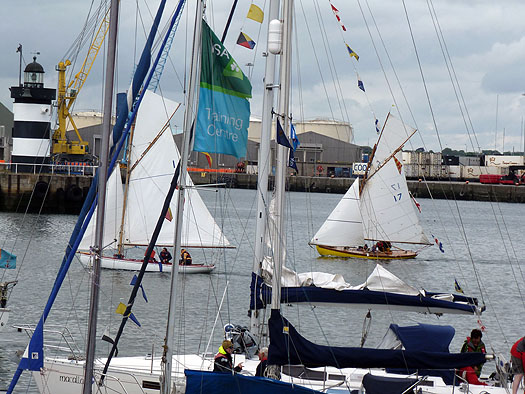
Rita (1) and Oona, the third boat in the dead heat in Saturday's race. Photo: W M Nixon
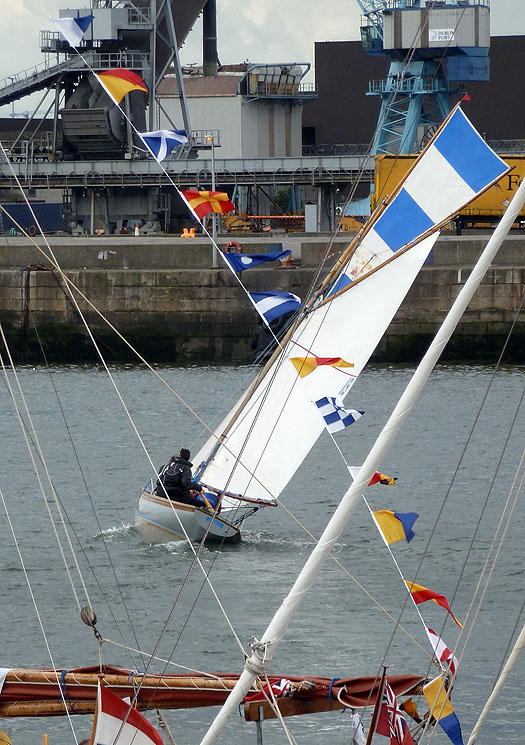
Looking every inch a classic, Brian & Conor Turvey's Howth 17 Isobel turns elegantly to windward in the Liffey. Photo: W M Nixon
The Saturday night saw the Poolbeg complex a hive of socializing with boat talk and boat visiting and all the usual things that sailors get up to in port. We've already given a hint of the variety of boats, but the gathering in Poolbeg also included serious stuff like the mighty 55ft Annabel-J (Philip Cogdell), authentically built in 1995 with inspiration from classic Bristol Channel Pilot cutters, and the hugely impressive 44ft steel gaff yawl Young Larry (Andrew Wilkes and Maire Breathnach), which last year completed an extraordinary cicumnavigation of North Amrica, having transitted the Northwest Passage in one season.
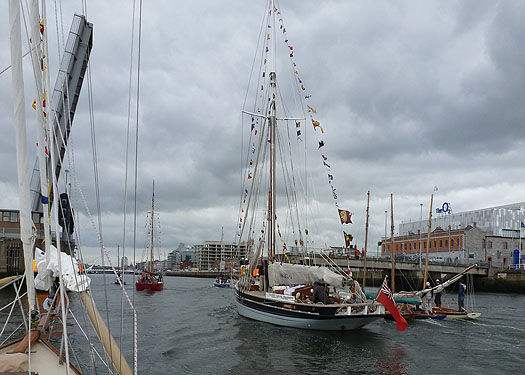
Through the bridge. The big pilot cutter Annabel-J and a trio of Howth 17s heading for the Eastlink. Photo: W M Nixon
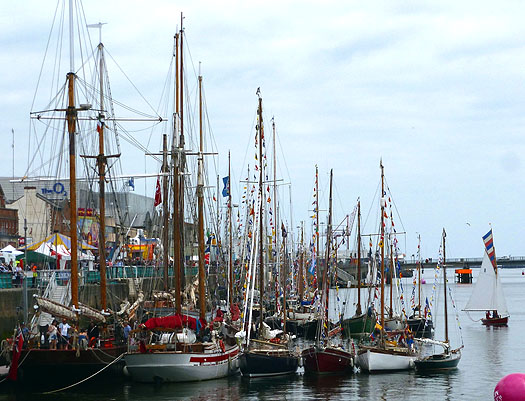
The fleet's in town – the two boats right foreground are the white 31ft cutter Witch (built 1898) and the 25ft Marguerite (built 1896). Photo: W M Nixon
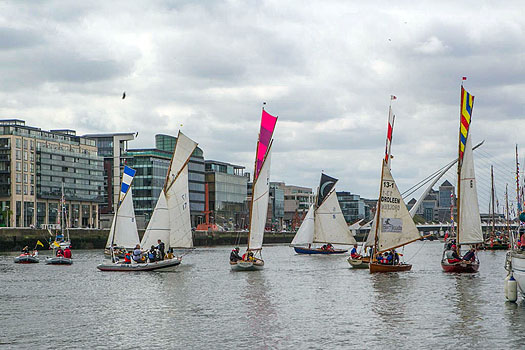
History in the making - Howth 17s and the lone Bray Droleen in the heart of the city Photo: W M Nixon
With boats like that all in the one place, you could have spent a week in detailed examinations. But soon enough it was Sunday morning, and at 1100 hrs the entire fleet passed through the raised Eastlink Bridge for a good-natured raft-up along the quays and up to the MV Cill Airne (the restaurant boat), aboard which Dublin Bay OGA President Tim Magennis was over-seeing commentary duties during a hectic day which included two in-river races by Howth 17s, a crazy and wonderful maritime ballet by Dublin Port's state-of-the-art multiple movement tugs, the Shackleton and the Beaufort, there were informal parades by all sorts of craft including an authentic currach with an even more authentic piper, then too there was Yoshe the famous old gaffer dog from the Netherlands in his little dinghy powered by a vintage Seagull outboard, a Sikorski helicopter from air sea rescue put in an appearance, and somewhere in the middle of it all the Howth 17s put in two races in very light conditions which made it like a sort of waterborne mystery play, but they still got two good sets of results even if the wind died before they could sail a final race.
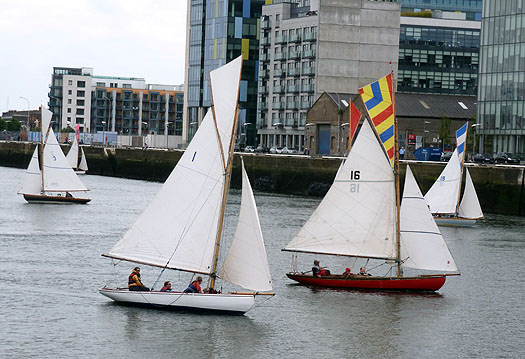
There was a very close river race between Marcus Lynch sailing Rita (1) and Davy Jones sailing Eileen (16) Photo: W M Nixon

Deilginis (Team Massey) won the second river race. Photo: W M Nixon
So it was announced that instead of having to make do with only one winner, they were ahead of the game – they'd finished the day with two champions. The first heat was really close, with Rita (Marcus Lynch and John Curley) staving off repeated challenges by Eileen sailed by Davy Jones and George Curley, with Conor & Brian Turvey in Isobel placing third. The other heat, in even flukier conditions, saw the Massey team in Deilginis come from nowhere by working a private air along the north side of the river (they're Northsiders of course) to take a clear lead from Peter Courtney in Oona, with Silver Moon, sailed by Windsor Laudan and Steph Ennis, placing third.
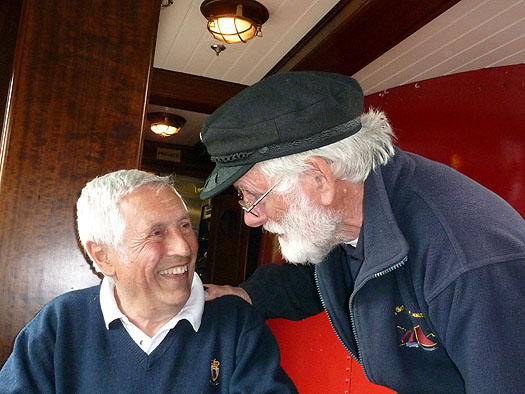
Senior sailors. Tim Magennis (President DBOGA, right) congratulates Dickie Gomes, skipper of Ainmara and winner of the Leinster Plate 2013, aboard the Cill Airne during the riverfest. Photo: W M Nixon
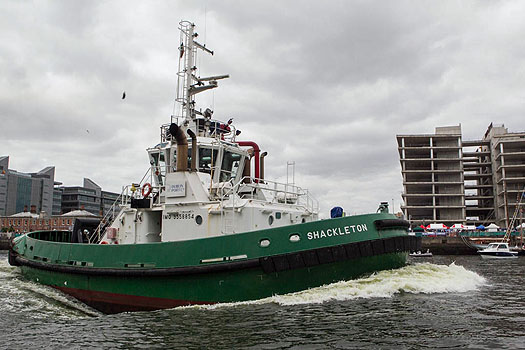
Dublin Port's state-of-the-art tugboats gave a fantastic display Photo: Barry O'Loughlin
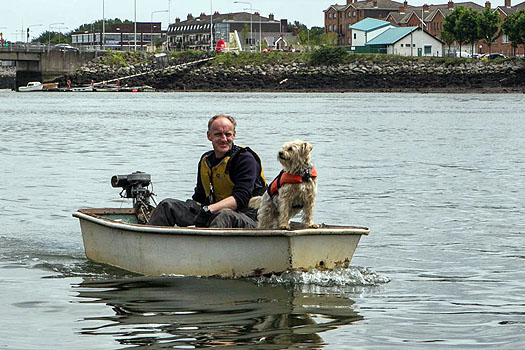
Old Gaffer pooch Koshe sailed to Dublin from The Netherlands, and toured the Liffey with his vintage Seagull outboard.
Photo: Barry O'Loughlin

Sails in the city Photo: Barry O'Loughlin

Water music, Liffey style Photo: W M Nixon
Needless to say when the Eastlink Bridge lifted again at mid-afternoon, despite highfalutin plans for a parade of sail everyone seemed to try leaving at once, but fortunately good humour prevailed on all sides. Invitably with the nature of a project like the Round Britain Challenge, some boats were already starting to think of moving on towards the next major gathering at Belfast this weeknd. And not surprisingly in a crowd of gadgeteers like the Old Gaffers, there were those for whom the siren call of the Isle of Man at TT time was just too good to resist.
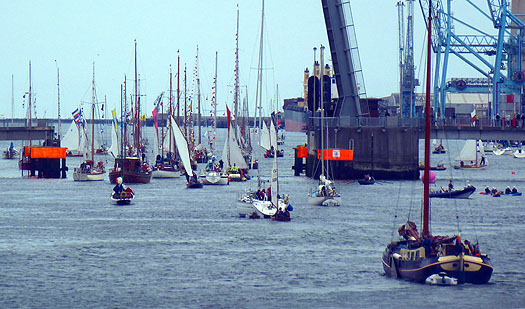
When the Eastlink lifted, everyone tried to leave at once, but there were no bumps. 64ft Ebenhaezer from Athlone (foreground) had the sense to wait. Photo: Barry O'Loughlin
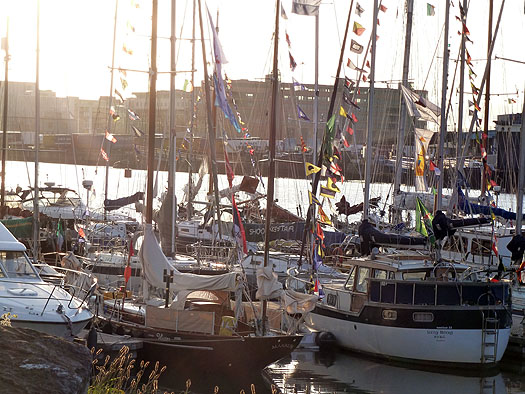
Winding down – summer evening at Poolbeg Photo: W M Nixon
Through the Sunday night, boats were quietly slipping away from the convivial throng at Poolbeg to head northeast for Peel under the Manx hills, and petrolhead heaven. But for others, it was a matter of gentle morning departure, after fulsome thanks to the kind hosts and wonderful hospitality of Poolbeg, away for a gentle and very sunny Bank Holiday Monday rounding of the Baily with Annabel J and Ainmara together, the big pilot cutter on a very leisurely progress for the first day with a new crew, planning a stop for lunch at Lambay and an overnight at Skerries, while the old yawl, her prizes secure, went on past the roseate terns rampant at Rockabill, and fetched up that night comfortably in Ardglass.

Quiet day at sea – Annabel-J on passage towards Lambay on Bank Holiday Monday Photo: W M Nixon
But for some really keen Old Gaffer sailors, Bank Holiday Monday in Dublin Bay meant the first race for the Asgard Trophy, created by conservator John Kearon from bits saved from the saving of Erskine Childers' Asgard up in Collins Barracks. With the high pressure system well settled on Ireland, it was into the afternoon before there was a hint of a breeze, but the fleet had waited in patience, and they got a race and a result.
This time round, it was Tir na nOg's turn to take the prize by 63 seconds from Denis Aylmer's Mona, which means that over the two races of OGA50 racing in Dublin, Sean Walsh's cutter is the overall winner. He certainly deserves it – the quiet but steady effort as DBOGA Honorary Secretary that Sean put in over the winter to bring it all together made for a fantastic time for everyone.
Asgard Trophy 2013 1st Tir na nOg (Sean Walsh, Poolbeg) 00:52:11; 2nd Mona (Denis Aylmer, Dun Laoghaire) 00:53:14; 3rd Verve (Brian Comerford, Dun Laoghaire), 00:53:48; 4th Dreva (1936 34ft gaff cutter, Joe Ormond, North Wales) 00:54:53; 5th Marguerite (1896 25ft gaff cutter, owned Tim Magennis Dun Laoghaire, sailed Sean Cullen) 00:57:03.
This weekend, the fleet are well gathered in the new Belfast Harbour Marina right beside the extraordinary Titanic Belfast centre, close to the newly-restored ship Nomadic, the "miniature Titanic". She is so newly re-commissioned that tonight's OGA50 party on board is the first official function on Nomadic in decades. And then the fleet heads on, some to return directly to their home ports, others to continue the circuit via the Caledonian Canal, and others like Annabel-J making a real job of it by going north to the Shetlands before finally shaping their course southwards to many hospitable ports before the OGA50 Challenge reaches its conclusion with a mighty gathering in Cowes in mid-August.
We enjoyed our new friendships made at Poolbeg in the glorious first weekend of June. Now we'll follow their summer-long progress with special interest, these lovely people with their long bowsprits, their weird and wonderful boats, and their engaging enthusiasm.
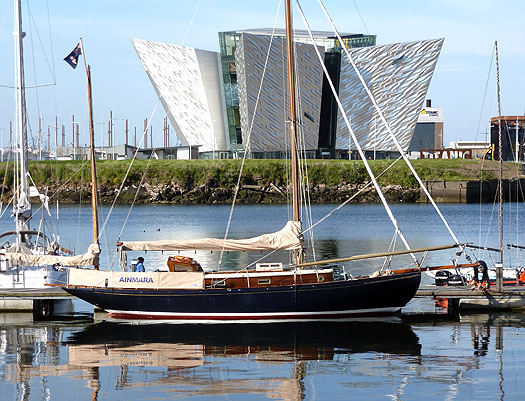
Where is everyone? Ainmara was one of the first to reach Belfast, and is seen here berthed at the new Titanic Belfast centre on Tuesday evening. The OGA50 party continues there tonight. Photo: W M Nixon
Comment on this story?
We'd like to hear from you! Leave a message in the box below or email William Nixon directly on[email protected]
WM Nixon's Saturday Sailing blog appears every Saturday on Afloat.ie
Follow us on twitter @afloatmagazine and on our Afloat facebook page
Old Gaffer Gold for Centenarian Ringsend Lady
#oga – In testing conditions on Dublin Bay, one of its own took line honours in yesterday's inaugural Leinster Trophy race on Dublin Bay. The 36ft yawl Ainmara built by John Kearney in Ringsend in 1912 and campaigned by Dickie Gomes of Strangford Lough took the race over a round Dublin Bay course of eight miles.
Upwards of ten boats participated in the first race of the Old Gaffers Association's 50th anniversary this bank holiday weekend, hosted by the Poolbeg Yacht Club, part of a necklace of events in the Round Britain Challenge to mark the association's 50th anniversary.
The 36ft–yawl Ainmara, immaculately restored by Gomes, marked her return to Dublin bay waters last Friday when she sailed back to the National Yacht Club, her first return in 90 years. Gomes with crew Brian Law and Afloat's W M Nixon were welcomed by another Kearney design, the Dublin Bay Mermaid at the harbour mouth and escorted to her East Pier berth, for an evening of celebration at the club house where Kearney was a former flag officer.
For more on the legacy of John Kearney read WM Nixon's blog and for more of the Old Gaffers click here.
The Sailing Legacy of John Breslin Kearney
#irishmaritimehistory – It was a life which would have been remarkable by any standards, in any place, at any time. But in the Dublin of its era, this was a life of astonishing achievement against all the odds, in a rigidly structured society made even more conservative by a time of global unrest and national upheaval.
John Breslin Kearney (1879-1967) was born of a longshore family in the heart of Ringsend in Dublin, the eldest of four sons in a small house in Thorncastle Street. The crowded old houses backed onto the foreshore along the River Dodder in a relationship with the muddy inlet which was so intimate that at times of exceptional tidal surges, any ground floor rooms were at risk of flooding.
But at four of the houses, it enabled the back yards to be extended to become the boatyards of Foley, Murphy, Kearney and Smith. Other houses on Thorncastle Street provided space for riverside sail lofts, marine blacksmith workshops, traditional ropeworks, and all the other long-established specialist trades which served the needs of fishing boats, and the small vessels - rowed and sailed - with which the hobblers raced out into Dublin Bay and beyond to provide pilotage services for incoming ships. And increasingly, as Dublin acquired a growing middle class with the burgeoning wealth of the long Victorian era, the little boatyards along the Dodder also looked after the needs of the boats of the new breed of recreational summer sailors.
The young John Kearney was particularly interested in this aspect of activity at his father's boatyard, where he worked during time away from school. From an early age, he developed a natural ability as a boat and yacht designer, absorbing correspondence courses and testing his skills from 1897 onwards, when he designed and built his first 15ft sailing dinghy, aged just 18.
He was apprenticed in boat-building to Dublin Port & Docks across the river, qualifying as a master shipwright. But his talents were such that he rose to the top in all the areas of the port which required the designing and making of specialised structures, some of them very large. So in addition to building workboats of all sizes, he played a key role in projects like the new pile lighthouse at the North Bull, for which he developed support legs threaded like giant corkscrews, and rotated into the seabed like monster coachbolts.
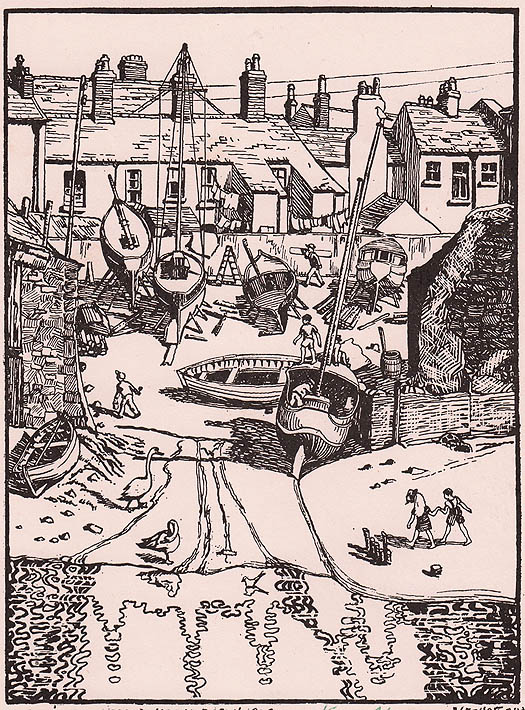
Murphy's Boatyard on the Dodder in Ringsend in the rare old times is perfectly captured in this woodcut by Harry Kernoff RHA. It was all disappeared in 1954, when the old houses of Thorncastle Street were replaced by a complex of Corporation flats of such good quality that they have recently had a major refurbishment.
He also pioneered the use of reinforced concrete for pre-fabricated harbour constructions, and when the Great War broke out in 1914, his special talents and experience were called upon to advise on quick-build ferrocement structures of all kinds. Although Ireland remained neutral as World War II broke out in 1939, the Dublin engineering firm of Smith and Pearson established a yard in Warrenpoint just across the border to build concrete barges and small ships for war work, and John Kearney was their consultant.
So far-reaching was his input into developing the infrastructure of Dublin port that when he retired in 1944, while his official title was as Superintendent of Construction Works, he was de facto the Harbour Engineer. But he couldn't be properly acknowledged as such, because he had never qualified from a third level college - it was far from universities that the Kearneys of Ringsend were reared.
However, this lack of an official title left him unfazed, for his retirement at the age of 65 meant he could concentrate full-time on his parallel career as a yacht designer, something that was so important to him that when his gravestone was erected in Glasnevin in 1967, it simply stated: John Kearney, Yacht Designer.
He had developed his skills in this area ever since his first boat in 1897. In 1901, when he was still 21, a 17ft clinker-built canoe yawl, the Satanella which Kearney designed and built for noted Dublin Bay sailor Pat Walsh, was praised in the London yachting press. Her owner camping-cruised this little boat successfully along the great rivers of Europe before World War 1, getting there simply by sailing his canoe from Dun Laoghaire into Dublin Docks, and striking a shipping deal with whichever ship's captain was heading for a port on the desired river.
Kearney had been busy for the ensuing nine years with his growing responsibilities in Dublin Port. But in 1910 he reserved a corner of Murphy's Yard, and in the next eighteen months, working in his spare time entirely by hand with the light of oil lamps, he built his first personal dreamship, the 36ft gaff yawl Ainmara, to his own design. In this his first proper yacht, he immediately achieved the Kearney hallmark of a handsome hull which looks good from any angle, a seakindly boat which was gentle with her crew yet had that priceless ability of the good cruising yacht – she could effortlessly maintain a respectable average speed over many miles while sailing the high seas in comfort.
Built in straightforward style of pitchpine planking on oak, Ainmara was highly regarded, and though the world was at war for four of the ten years John Kearney owned her, when he could sail his preferred cruising ground was Scotland. She was no slouch on the race course either. Her skipper became a member of Howth Sailing Club in 1920, and HSC's annual Lambay Race became a Kearney speciality, his first recorded overall win being in 1921 when, in a breezy race, Ainmara won the cruisers by one-and-a-half minutes.
Despite the turmoils of Ireland's War of Independence and Civil War, in the early 1920s John Kearney's position with the Port & Docks had become so secure that in 1923 he felt sufficiently confident to sell Ainmara in order to clear the way to build himself a new boat, the superb 38ft yawl Mavis, which was launched in July 1925. He was to own, cruise and race her with great success for nearly thirty years, by which time he was a pillar of the Dun Laoghaire sailing establishment – he'd a house in Monkstown, and had become Rear Commodore of the National Yacht Club, a position he held until his death in 1967.
Even with the demands of his work, and the continuing attention needed to run a yacht of the calibre of Mavis, he had found the time to design and sometimes also build other yachts of many types. What he didn't seem to have time for was simple domesticity. In later years his presence was enough to command respect, but in his vigorous younger days he could be waspish, to say the least, and a brief attempt at marriage was not a success.
Sibling relationships were also sometimes tense. Two of his brothers were boatbuilders and one of them, Jem, was almost always daggers-drawn with John. And Jem Kearney had regular battles with others, too. He was a classic Dublin character, and no stranger to salmon netting on the Liffey in circumstances of questionable legality. If one of these expeditions had been spectacularly successful, he would erupt triumphantly back into his family's little house on the East Wall Road and announce: "Pack you bags, Mrs Kearney, we're off to stay in the Gresham!" And he meant it, too. Mr & Mrs Jem Kearney of the East Wall Road became resident in the Gresham Hotel until the salmon money ran out.
So when he was building Mavis, John Kearney would only work with his brother Tom, and they were a fantastic team. But even that didn't last. One November night, working away at planking the hull, they took a break for a mug of tea at 9.30pm, and couldn't find the sugar. Each blamed the other for its absence. The row was seismic. The following night, each turned up with his own personal supply of tea, milk and sugar. And the work continued as smoothly as ever. But not one single word was exchanged between the two brothers for the remaining eight months of the project. It was years before they spoke again.
Quite what this meant when Mavis launched herself on St Stephens Day 1924 we can only guess. Like Ainmara eleven years earlier, Mavis could only be accommodated in Murphy's shed by being built in a large trench, and an exceptional Spring tide on December 26th 1924 saw her unplanned flotation. There was no damage done, but history doesn't record whether it was John and Tom who sorted the problem together despite not saying a word.
The immaculate Mavis made an immediate and successful impact, and Skipper Kearney and his beloved gaff yawl were honoured guests at regattas all along the east coast. While continuing to work full time for the Port & Docks, he kept up the spare-time yacht-building, but after the experiences with Mavis, when a regular Kearney crewmember, Billy Blood-Smyth, commissisoned a new 35ft gaff yawl from the skipper, it was client and designer who had to work together in the familiar corner of Murphy's yard to build the boat which became Sonia, launched in 1929.
Irish sailing was in a very quiet phase through the 1930s. Just about the only expanding organization was the Irish Cruising Club, and naturally John B Kearney and Mavis were on the first membership list in 1930, with Mavis a regular competitor in its offshore races, with a notable victory in the stormy 1935 race to the Isle of Man, a performance which won special praise from another participant, Humphrey Barton who was to found the Ocean Cruising Club 19 years later.
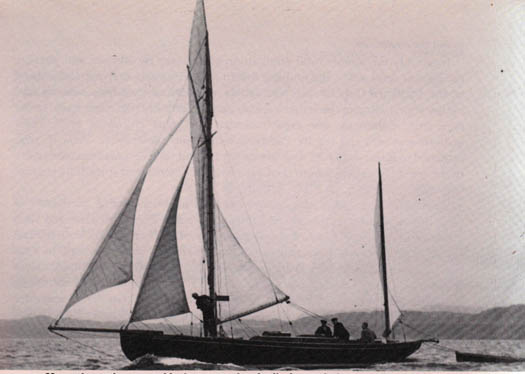
Mavis coming into port after winning the Clyde Cruising Club's annual Tobermory Race in 1938. Club rules at the time stipulated that as proper cruising yachts, the competing boats should tow their tenders throughout this race. Much effort went into designing sweet-lined dinghies.
Mavis also was overall winner of the Clyde Cruising Club's Tobermory Race in 1938. But while his own sailing was going splendidly, John Kearney was concerned at the sluggish state of sailing development in Ireland. In order to give younger people an opportunity to own their own boat, in 1932 he created the design for the 17ft Mermaid, a large clinker-built sailing dinghy which was designed to be constructed for around £180 - roughly the same price as a motorbike. The Mermaid was adopted by Dublin Bay SC, but it took a long time to gain momentum, and it wasn't until the late 1940s and early 1950s that it became the most popular class in the greater Dublin area. It is still active today with nearly 200 boats built, and more than 40 took part in its 80th Anniversary championship last summer in Skerries, the winner being Jonathan O'Rourke from the National YC,while the furthest travelled was Patrick Boardman's Thumbalina from Rush, which had started from Foynes on the Shannon Estuary, home to the most distant Mermaid fleet, and had – most impressively - sailed all the way round the south coast to Skerries to mark the 80th birthday.

The Mermaid was designed in 1932 to be built at the same price as the average motor-bike
With his retirement in 1944, John Kearney's design work came centre stage, and he was busy to the end, creating more than 20 cruising yachts in all. And life in Monkstown was pleasant. Over the door of the room where he did his design work, he'd a little motto on a brass plate: "God gives us our relatives. Thank God we can choose our friends". His close friends were all from sailing, and it was a crew member who had joined Mavis in 1946, the formidable Miss Douglas, who became his friend and housekeeper and looked after him to the end of his long and remarkable life.

John Kearney, aged 83, working at the drawings of his last design, the 54ft yawl Helen of Howth Photo: Tom Hudson

Sonia, built 1929, cruising in British Columbia, her home waters since 1958 Photo: Jeff Graham
John Kearney's entire life is in its way a great legacy, and his fine boats are his tangible memorials. They've ventured to the far corners of the world. For instance, the 30ft Evora, a lovely Bermudan yawl which he designed for building by Skinner's of Baltimore in 1936, was last reported from Darwin in Australia. The pretty Sonia of 1929 is well at home these days in British Columbia. And as for Mavis, the crème de la crème, she is currently undergoing a painstaking restoration in Maine by shipwright Ron Hawkins, who is very encouraged by the amount of original material he is able to retain.
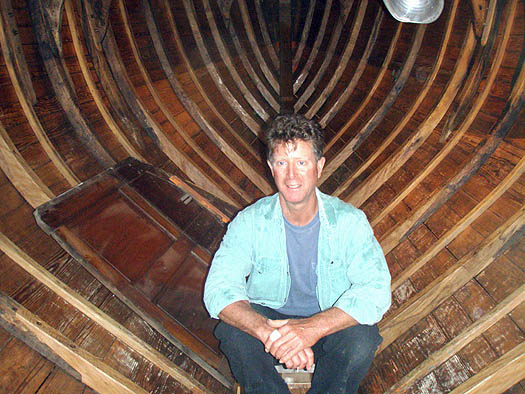
Ron Hawkins in Mavis at an early stage of his restoration project Photo: Hal Sisk

Ron Hawkins has been much encouraged by the amount of original material he has been able to retain in restoring Mavis Photo: Denise Pukas
John Kearney's first proper yacht, the 9-tonner Ainmara from 1912, has been owned for 47 years by former Round Ireland record holder Dickie Gomes of Strangford Lough. Last year, she celebrated her Centenary with a cruise to the Outer Hebrides. This year - next week in fact - she hopes to be in Dublin Bay for the Old Gaffers Association Golden Jubilee. And as it will be at Poolbeg Yacht & Boat Club, Ainmara will be back home in Ringsend for the first time in 90 years, and John Breslin Kearney will be well remembered, and celebrated too.
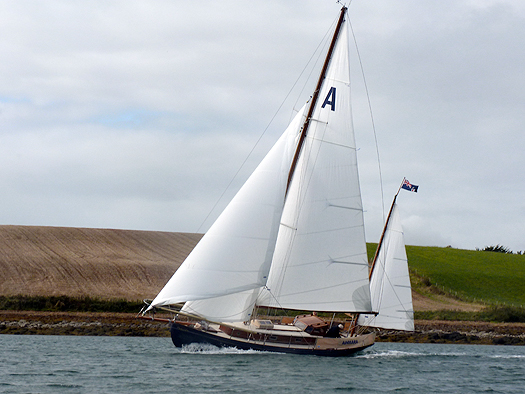
Still going strong. Dickie Gomes is the happy owner aboard Ainmara, which will be returning to Ringsend next week 101 years after she was built there to his own designs by John B Kearney Photo: W M Nixon
Comment on this story?
We'd like to hear from you! Leave a message in the box below or email William Nixon directly on [email protected]
WM Nixon's Saturday Sailing blog appears every Saturday on Afloat.ie
Follow us on twitter @afloatmagazine and on our Afloat facebook page
Gaffers Gradually Gathering for 50th Anniversary Sail
#oga50 – The continuing harsh weather has made it rugged going for vintage boats and veteran owners as they get themselves together for this year's Old Gaffers Association 50th Anniversary cruise, which started on April 21st in a brief spell of gentler Springlike conditions from Maldon in Essex, birthplace of the OGA in 1963.
The format of the cruise is a voyage round Great Britain, with some boats going all the way while others join and leave as they please. There's a diversion in a fortnight's time in the Irish Sea westward to Dublin Bay for the Bank Holiday weekend at the start of June, and this will see the OGA50's first assembly of classic and traditional boats in significant numbers. With the programme continuing throughout the summer, numbers will continue to build until it concludes with a mighty Golden Jubilee regatta in Cowes in mid-August.
The Old Gaffer enthusiasts are nothing if not individualists, with boats to match, so getting them to move in the same direction, and at the same time, is about as easy as herding cats. As for speeds, they vary enormously, so it is it all being done within broad parameters, with reliance on good will and the camaraderie of the sea to keep together a fleet of mind-boggling diversity.
The April starters from the heartlands of the association in places like Maldon and Pin Mill and other East Anglian ports were soon joined by a strong contingent from the Netherlands, and gradually they've made their way south and west with the first proper gathering taking place in Southampton Water on May 4th and 5th.
Sailing their home waters of the Thames Estuary takes it own special skills, but it's only natural that those who are more accustomed to working their way among sheltered mudbanks tend to see the coastlines down towards Land's End and the Atlantic as a particularly challenging area. Unfortunately, the seaways and the weather Down West have done nothing to diminish this, with Maytime snow falling in Devon, and winds of Force 10 seeing the boats holed up in every port from the Solent down to Penzance.

Thames sailing barges at Pin Mill in East Anglia, a world away from the rugged Atlantic waters of Land's End. The founders of the Old Gaffers Association in 1963 kept their boats at snug ports like this, but their Golden Jubilee Cruise is taking on the challenge of sailing on waters of all kinds. Photo: W M Nixon
But with the handsome 55ft Annabelle J (Philip Cogdell) setting the pace as befits a 1995 take on the classic Bristol Channel Pilot cutter concept, this weekend the leaders have reached Milford Haven to link up with boats from South Wales and the Bristol Channel area. The festivities will be mighty, but with the challenge of Land's End astern, the distances are now modest, and it becomes a sort of royal procession, as in a week's time they'll be making the scene in Holyhead. And after that, it's only 55 miles across Channel to join the growing throng in Dublin Bay.
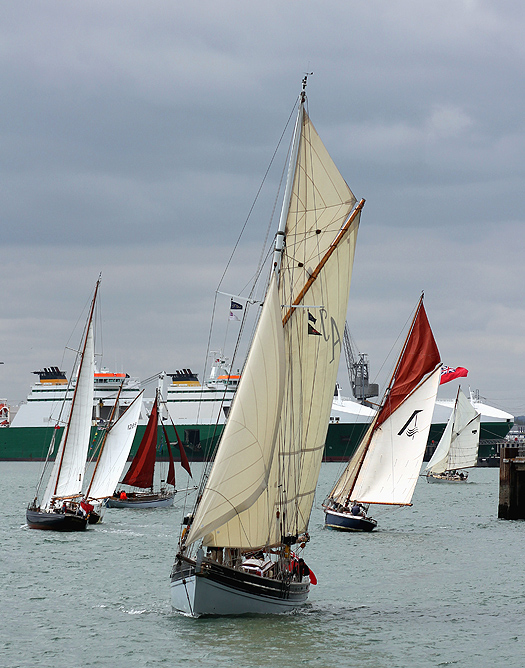
The 55ft Annabel J steps out at the initial sailpast in Southampton a fortnight ago. She has been setting the pace in the gale-dogged progression down to Land's End and north to Milford Haven. Photo: Keith Allso
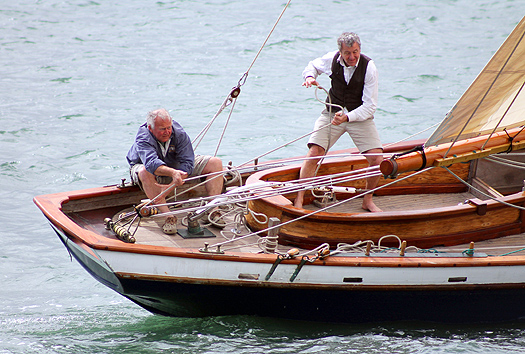
Every finger a marlin spike.......a pair of hard chaws convince themselves that summer has arrived aboard Aeolus in the Southampton sailpast Photo: Keith Allso
Obviously such a relaxed programme anticipates that different crews will have their own variations on the basic themes, and already one of the Dutch participants, Rik Janssen's 46ft Cine Mara, has kept to the northwest after Land's End, and is heading for Cork. But that was always on the cards, as Cine Mara is a steel-built Galway Hooker, and if she doesn't actually get to Galway Bay, at least some Galwegians might come a-visiting if she can get to Cork before heading for Dublin Bay.
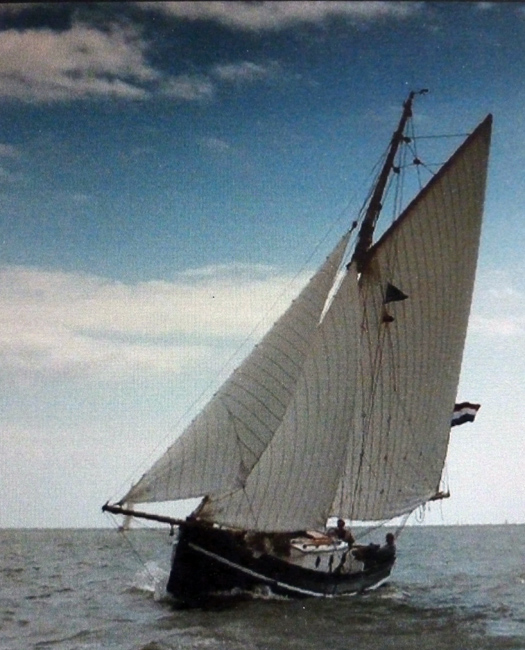
The 46ft Cine Mara (Rik Janssen) is a steel-built Galway Hooker
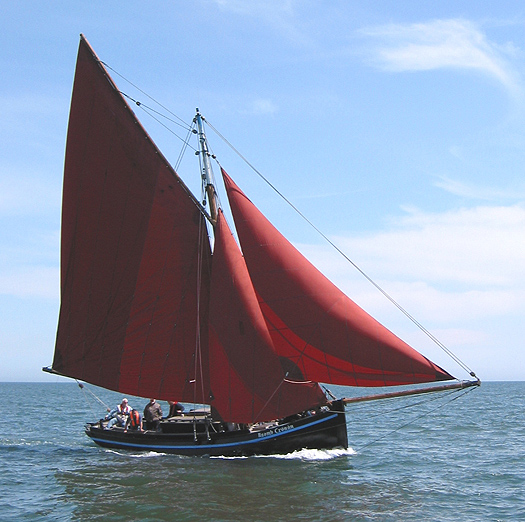
Built by the Dublin co-operative which owns and sails her, the Galway Hooker Naomh Cronan is a regular participant in Old Gaffer events. Photo: W M Nixon
By the time Dublin Bay is reached, there'll be enough gaffers of all kinds taking part to satisfy even the most fastidious enthusiasts, and entries include the senior of them all, Adrian "Stu" Spence's much-travelled 43ft former Bristol Channel pilot cutter Madcap from Strangford Lough, built in Cardiff in 1875. There's even a 64 footer coming direct from the west from the Midlands, down the Shannon from Athlone, then through the Grand Canal to the Liffey. This is Rachel Leech's 64ft Dutch tjalk Ebenhaezer, normally an adornment of Lough Ree, but the Poolbeg party was too good to miss.
Joining her from about as far east as it is possible to get in England is another cutter of special interest, the 1898-built Witch (Alastair Randall). With her home port on the lovely Walton Backwaters, Witch is a long way from her birthplace, as she was designed and built by Dickie's of Tarbert on Loch Fyne to be the sailing ferryboat for the Scottish island of Gigha, a role which she fulfilled for 20 year before being converted to a cruising yacht in 1918.

The 31ft cutter Witch was built in 1898 to be the ferry boat for the Scottish island of Gigha.
Even as Witch was under construction in Tarbert, across the North Channel in Carrickfergus on Belfast Lough the first five boats of the Howth 17 class were being built by John Hilditch to the designs of Herbert Boyd. All five boats are still sailing 115 years later, they have thirteen newer sister-ships also surviving, and around a dozen of the class will be taking part in the OGA 50th events in Dublin Bay.
The programme is busy, to say the least. The main event on Saturday June 1st is a race for the cruisers for the RMS Leinster Trophy, which has been presented by the postal workers union to commemorate the hundreds who were lost on RMS Leinster when she was sunk by two torpedoes from a German U Boat in 1918 five miles east of the Kish, remembering in particular the 21 postal workers who died in the mail-sorting room when the ship went down in minutes.
The race course will start from Dun Laoghaire, and will follow at least part of the Leinster's route on that fateful day, before returning to Dublin Bay and a finish at Poolbeg. By that time the Howth 17s should be there, as they start from Howth at 0900hrs on the Saturday morning to get into Dublin Bay before the tide starts to run north.
On Sunday, the entire fleet goes up the Liffey through the East Link and is based along the quays, while the Seventeens stage a historic in-city race between the bridges. Then it's back to Poolbeg that evening, and on Monday things wind down in gentler style with a 1300 hrs start for an all-comers race in Dublin Bay for the Asgard Trophy, specially made by marine conservator John Kearon from spare materials saved from Erskine Childers' Asgard when he was in charge of the preservation process.
It's an appropriate way to conclude the Dublin Bay events, as many of the boats taking part are miracles of loving preservation projects. It's a matter of wonder, for instance, that the Howth 17s are not only still going, but they're still going strong. It's not as if they're handled gently when they're sailed. On the contrary, after 115 years, they're still raced flat out. Maybe there's a lesson for us all in this.

It's the way they sail them....The 1898-built Howth 17 Aura (Ian Malcolm) enjoying a bit of extreme sport in wind-over-tide conditions in Howth Sound. Photo: Jaimie Blandford
Comment on this story?
We'd like to hear from you! Leave a message in the box below or email William Nixon directly on [email protected]
WM Nixon's Saturday Sailing blog appears every Saturday on Afloat.ie
Follow us on twitter @afloatmagazine and on our Afloat facebook page
Galway Offshore Racer Achieves Perpetual Motion
"Harbour rots ships and ruins men". So said Horatio Nelson. He not only knew it from his own extensive command experience, but from time to time during long stays in port, he proved it personally with cringe-making results. He should have remembered that other saying of the sea: A busy ship is a happy ship. And at a more basic level, surveyors and boat maintenance experts will tell you the simple truth, that boats and their equipment usually don't get worn out, but they slowly rot through disuse.
With modern materials, it's not rot as they'd have known it in Nelson's day. But whatever you might call it, it makes things non-functional. Yet a boat which is on the move - sailing regularly and extensively - soon has everything working sweetly, for the demands of the sea are such that the attitude of "sure 'twill do" soon provides its own come-uppance.
Out in the west, they've an attractive boat which is making a fair bid to be a perpetual motion machine, with everything functioning smoothly. It's not that long ago that Martin Breen of Galway bought the Reflex 38 Lynx, but since then she has been in the frame in so many major offshore events, and under so many different sponsorship names, that you could be forgiven for thinking he's owned her for more than a decade, and that there are two or three different boats involved.
At the time he bought her, we noted that she seemed to be the ideal size of boat for Irish conditions. The First 40.7, globally the most successful production-built frontline offshore racer of the past twenty years and a super boat with it, is just that little bit too big for Irish conditions in terms of personnel demands and maintenance requirements. But if you go down to some of the hotter 36ft and 34ft machines, you often find you're missing the boat in terms of catching tidal patterns, and the basic realities of seagoing comfort, even though the brilliant J/109 frequently proves otherwise.

Settling in shortly after the start of the Dun Laoghaire to Dingle, 2011
But 38ft LOA - that is just spot on. When Christian Stimson created what is now the Reflex 38 in 1998, he came up with a concept which has withstood the test of time. She can sail up to her rating, and has proven a steady and successful performer in a wide variety of conditions, proving that the comment by Robert Scheidt - that sailing is a consistency sport - applies every bit as much offshore as in the bays.
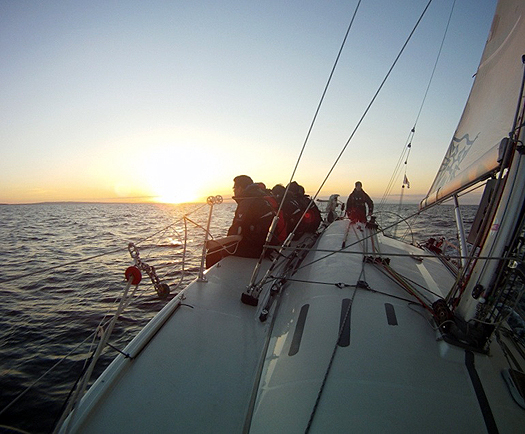
Successful debut. Dawn comes gently over the boat in winning mode in the Dun Laogaire-Dingle Race 2011

Pre-start manoeuvres off Wicklow at the 2012 Round Ireland Race
The new Breen boat made her Irish debut with the Dun Laoghaire-Dingle Race in 2011, and really stuffed it into the fleets from other Irish coasts, for she raced as Galway Harbour, and had an excellent overall win. Then last year it was active members of NUI Galway SC past and present who took her over under the leadership of Cathal Clarke, and they became the ICRA Boat of the Year with a superb all-round programme which included a class win in a major ISORA race, and the class win – including beating the hottest Reflex 38 from Britain – in the Round Ireland Race.
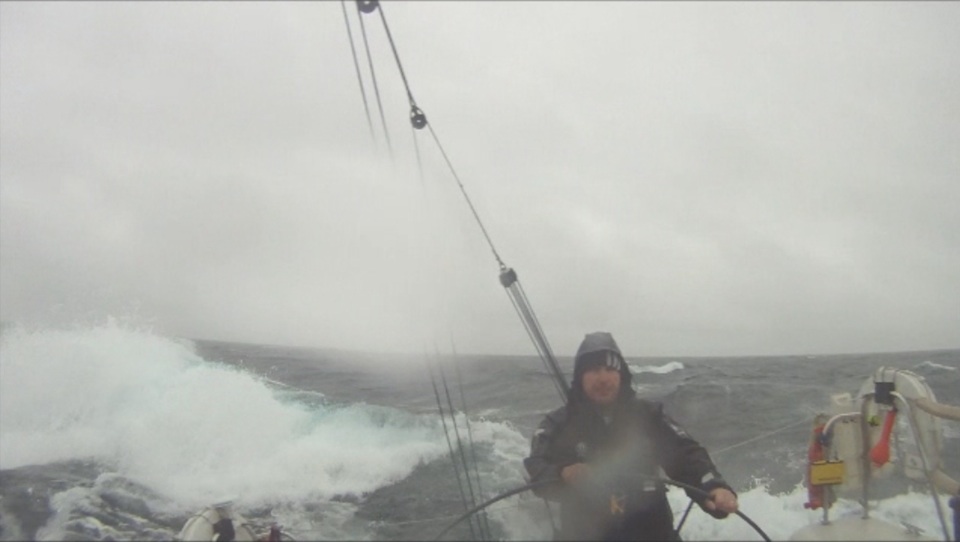
Not always sunny – determined conditions in the Round Ireland Race 2012
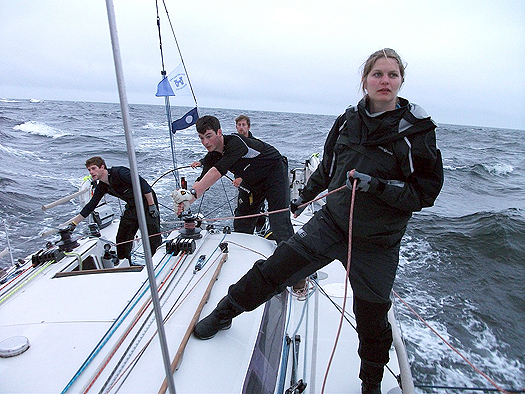
Grey day at sea, Round Ireland Race 2012, with Joan Mulloy from Mayo SC trimming the spinnaker
Between times, the boat didn't rest, as Martin Breen has his own crew for inshore regattas. But this year, the pace is into an even higher gear with Aodhan Fitzgerald (who has been involved since the boat first reached Ireland) in overall charge offshore in a programme which is simply mind-boggling. It was launched yesterday evening in Galway with the boat now in the Discover Ireland livery, and she'll be promoting the Emerald Isle and The Gathering Cruise in a series of campaigns which start today off Rinville at 1000hrs with the 60-mile Clarenbridge Crystal Race in Galway Bay. The crew will be clad from head to toe in new kit provided by Dubarry, with the boat setting a fine new set of threads from Des McWilliam, saling in conditions which look most unlikely to include any calm spots.
Then it's off to Scotland round Ireland's bumpy nor'west corner for the Scottish Series from May 24th to 27th with the boat to be raced by Martin Breen's GBSC team, then south to Dun Laoghaire to be on station for defending the Dun Laoghaire to Dingle title, starting the 266 mile course (which is also a Fastnet qualifier) on June 7th, then on from Dingle it's immediately into the WIORA and ICRA championships just round the corner at Fenit on Tralee Bay, then before June is out, they're challenging for the Sovereign's Cup in Kinsale.
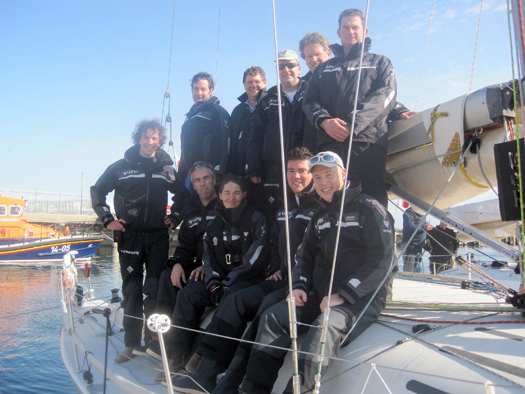
The gang's all here – the 15-strong crew panel's select offshore squad
The total crew panel is 15, ranging in age from 19 to 55, and for the offshore programme the lineup is Aodhan Fitzgerald (skipper/navigator), Johnny Murphy (tactician/trimmer), Neil Spain (driver), Ben Scallan (driver), Martin Breen (driver), Cathal Clarke (bowman), Joan Mulloy (trimmer), Nigel Moss (trimmer), Ruairi de Faoite (mast), and Louis Mulloy (bowman).
While the crew emphasis is on Connacht, in the way of offshore racing this team also includes people from most other parts of Ireland, people that you'd meet in the course of other campaigns, people who seem to fit in with your own boat's way of doing things. If you tried to delineate a clear career path on how to become part of a group like this, you'd find it very difficult. There is no clearcut way. It seems to happen by a mixture of telepathy and osmosis. You are impressed by the way people are sailing another boat, and you make it your business to get them inside your tent.
Because for sure, the business of successfully balancing different temperaments is going to be paramount in a season in which they're only getting going as the Sovereign's Cup draws to a close. The high point of the year is going to be the Rolex Fastnet Race in August. By the time the boat gets to Cowes, she'll have sailed more than a thousand miles in delivery trips.
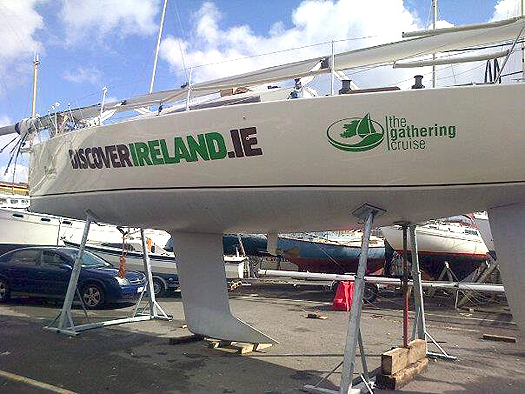
Stating the obvious? Starting the Rolex Fastnet Race with this message emblazoned on your topsides is going to invite ribald comment from the opposition. But displaying something similar has proven successful in the past.
And there she'll be in the Solent among 350 other Fastnet wannabees, with Discover Ireland boldly displayed along her topsides. They'll be getting some smartass comments about that. After all, what else is the Fastnet Race all about? Back in 1975, when the Golden Jubilee Fastnet Race included a fleet for classics racing for the Iolaire Block presented by Don Street, one splendid old gaff cutter had her crew all kitted out in crisp new T-shirts, each one imprinted with different letters. When they all lined up along the rail, those T-shirts read: "What is the way to the Fastnet Rock, please?" In Irish. And it worked. They won the Iolaire Block, even though Iolaire was herself racing. So let's hope that having discoverireland.ie emblazoned prominently on the topsides is going to be equally successful in the Fastnet Race for the boat formerly known as Lynx.
What with this extraordinary campaign, and the news this week about Galway plunging ahead with its new harbour, it's very clear that in the 21st Century, it's totally superfluous to warble on about the west being awake. For a long time now, it hasn't been asleep.
Comment on this story?
We'd like to hear from you! Leave a message in the box below or email William Nixon directly on [email protected]
WM Nixon's Saturday Sailing blog appears every Saturday on Afloat.ie
Follow us on twitter @afloatmagazine and on our Afloat facebook page
Dun Laoghaire Politician Hops on Afloat's Island
#dublinbay – The notion of an island on the Burford Bank at the mouth of Dublin Bay was mooted by Afloat's W M Nixon in his Sailing on Saturday blog on January 5th 2013, but now the idea has been aired again by Dun Laoghaire Green Party politico Ciaran Cuffe in his blog. He brings in references to other studies more serious than our light-hearted speculation, and links to a presumably artificial island off Copenhagen which seems to have become, in appearance at least, a Danish version of Cork Harbour's Spike Island.
We would point out that there's virtually no tide in the Copenhagen area, while the waters are more sheltered than the tide-riven surf battered conditions found out on the Burford Bank. And the Burford is of course totally made out of sand which - as any beach walker in Dublin can attest – is capable of being moved in hundreds of thousands of tons by just one tidal cycle. But who knows, as our item on January 5th pointed out, the Bull Island is a recent creation. That said, we also carried the warning that an inhabited sand island off Clontarf disappeared in a storm in 1844, taking an unfortunate father and son with it.
Extract from Afloat.ie 05/01/13
BANKING ON AN ISLAND
Why on earth are people throwing up their hands in horror at the news that hundreds of thousands of tons of material extracted from tunneling in Dublin is going to be dumped about three miles out to sea just beyond the mouth of the bay? This isn't a problem. This is an opportunity.
It has long been obvious that the Leinster coast needs more islands. In watching Sean Cullen's fascinating presentation about the INFOMAR surveys in December at Poolbeg Y & BC, and in particular his computerized displays showing the details of Dublin Bay, it became immediately obvious that the Burford Bank is an island which is just waiting to happen.
Think of how much more interesting Dublin Bay would be with its own Sable Island stretching for a mile or two north-south out where the Burford is now awash, providing shelter and an anchorage and somewhere to see, and maybe even visit?
After all, it's not so long ago that the Bull Island simply didn't exist. Yet now, thanks to the limited technology of the 19th Century in building the North Bull Wall, there it is – the Bull Island is one of the most important, welcome and popular features of the entire bay.
So surely with 21st Century technology we can manage something, and further out in the bay at that. But before creating new islands, be mindful that Dublin Bay has lost at least one. There used to be a Clontarf Island, and you can still see the remains of a house that was reputedly on it when you turn right off the Alfie Byrne Road to go along the front of Clontarf towards Howth. It looks like the ribs of an old shipwreck, or even the framework of a wooden pier, but it's apparently the lower skeleton of the house still there, but the island long gone.
Clontarf Island was noted as a healthy place to be when Dublin was afflicted by plague, so in the 1830s a wooden summer house was built on it by a Dublin publican called Christopher Cromwell. He is said to have been a descendant of Oliver Cromwell, and no, I'm not making this up, but somebody else may well have done so once upon a time. Anyway, on the 9th October 1844 Christopher and his ten year old son William were overnighting out on their island, and a mighty storm came up and swept everything away, sadly including father and son – their bodies were found along the shore, while most of the house was splintered along the then-new Great Northern Railway embankment, which ran along the beach but is now well inland.
It may well be that the reclaiming of land along the East Wall road with the consequent narrowing of the Tolka Estuary meant the island was also being eroded by the river as well as the sea, but it is a fact that an island which was shown clearly on all maps until 1844 – and whose ownership was at times disputed – had simply disappeared after the massive Autumn storm of 1844.
So we should bear this in mind when planning to build Burford Island. But with the ready availability of the basic material thanks to all this stuff which is going to be tunneled soon in Dublin, some rapid planning is necessary before it is all wasted by being dribbled into the sea somewhere off the Baily.
The great yacht designer John B Kearney, in his day job as the de facto Harbour Engineer to Dublin Port, led the way in experimenting with screw-in piling to support the North Bull Lighthouse at the entrance to Dublin Port. It would be a fine memorial to him if we could use the Kearney technique to drive a couple of hundred giant corkscrews into the Burford Bank in order to hold the tunnel waste in place, and thereby allow a sandbank to build up just like the Bull Island above high water level.
With the creation and expansion of the Bull Island almost within living memory, we have a very accurate record of the sort of plants which thrive in island-building in Dublin Bay, and a repeat of this out at the Burford would be a wonderful exercise which would provide employment for many specialists, and also of course be a tourist attraction.
In no time at all we would have the new island well covered with tough marram grass. Soon after that we could experiment with easy-growing cordylines, as most people think they're palm trees, and who are we to teach them otherwise? For what we want is an island in place in jig time, and if it looks like vaguely like an island of the South Pacific, so much the better. In no time at all there'd be a golf course on it, and then a casino, and a hundred years hence people will want to keep it exactly as it has become, because by then it will be an important part of our heritage.
Dunmore East: A Suitable Harbour for a Marina?
Dunmore East is a charmingly located and picturesque coastal village, whose enormous potential as a holiday and maritime centre is blighted by having an outdated and rather drab industrial zone at its core. For it has the misfortune to be trapped in its historical position as a long-established fisheries port. This means that the administration of the harbour – which should be the pleasant heart of the village – has been rigidly strait-jacketed into serving and promoting the demands of the fishing industry, often to the exclusion and certainly the detriment of the possible needs of any other potential harbour users, both afloat and ashore.
Were Dunmore East located on another part of Ireland's coastline, this might not matter too much. But the village is a popular holiday resort, and the harbour is in an absolutely key strategic location at local, regional, national and international levels in recreational boating. It is at the heart of a fine sailing area which – if there were proper berthing facilities available – would be ideal for hosting major events. An immediate example is the ICRA Nationals. Dunmore East would be a perfect location for this national annual cruiser-racer championship, yet there's no way it will be considered until the harbour is more welcoming to recreational boating.
But not only is Dunmore a potential venue port, it is the gateway to the largely untapped cruising potential of Waterford Estuary, and the Suir, Barrow and Nore rivers. In any other country in the world, this beautiful cruising land of the Three Sisters would be perceived as a national treasure. But in Ireland it is still receiving only minimal attention because the key to the whole place, the gateway port of Dunmore East, has not been welcoming.
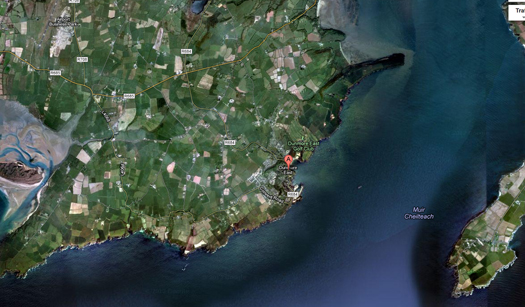
Dunmore East is both the heart of the coast, and the gateway to the magic cruising area of the Three Sisters - the estuaries of the Rivers Suir, Barrow and Nore. Photo: Google maps
Looking at the broader picture, Dunmore East's inhospitality affects the movement of cruising boats sailing along the coast. The large boat populations of the Irish Sea are discouraged from making the lengthy passage to the prime cruising areas of West Cork and Kerry because they're put off by knowing that if the urgent need arises, a visit to Dunmore East might not be a pleasant experience. Were the opposite the case, there would be an increase in the number of boats cruising the Irish coast generally. And a good experience in Dunmore East would also encourage them to sample the unexpected delights of cruising up to Waterford City or the port of New Ross, and visiting places little known to cruising men such as Duncannon, Arthurstown, Ballyhack and Cheek Point, not to mention the quiet anchorage behind Little Island in King's Channel.
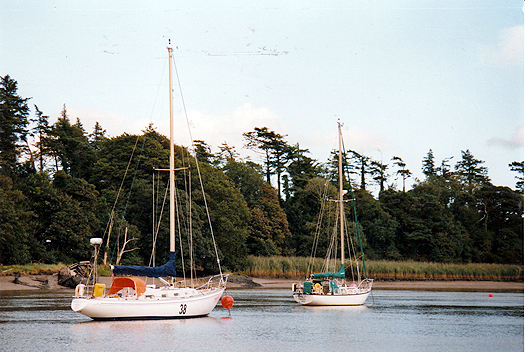
One of the Waterford Estuary's little known anchorages is in Kings Channel behind Little Island immediately east of Waterford City. Photo: W M Nixon
But you get only one chance to make a favourable first impression, and in recent years Dunmore East has been failing to do that. One of the saddest things about the place is the Visitors Book in the hospitable Waterford Harbour Sailing Club. Time was when each summer would produce a long list of the crews of visiting boats from near and far, and their enthusiastic comments. But these days the list has reduced to a trickle as the increasingly hostile demands of the harassed fishing industry have made the harbour bad-tempered, a place to be avoided.
Yet just along the coast, 15 miles to the eastward beyond Hook Point, there's a smaller port which manages to be both a thriving fishing port, and a welcoming marina. Kilmore Quay misses almost all the natural advantages of Dunmore East, as it's on an exposed and rocky coast. But it has just about everything else that Dunmore East lacks – it has enthusiasm, visible hospitality, and a can-do approach for boats of all sorts. So though it has the disadvantage that once berthed there, there is little you can do except stay put if the weather deteriorates, in every other way Kilmore Quay is streets ahead.
This is surely because Kilmore Quay is owned and run by Wexford County Council. With a vigorous council, enthusiastic county managers, and an energetic harbour master whose brief extends well beyond the stultifying limitations of the Department of Fisheries, Kilmore Quay is very much alive, while Dunmore East is moribund.
This would be fine if Dunmore East continued to be a major fishing port, but that's now a moot point. Fishing is becoming more truly industrialized by the day, and big boats with highly automated equipment and smaller crews are taking over the most profitable parts of the business. A port like Dunmore East, with its small size and draft limitations, is increasingly by-passed by the major operators. For sure, there'll always be fishing out of Dunmore East, but with an inbuilt boat size limitation it will increasingly be towards the artisan end of the fishing industry.
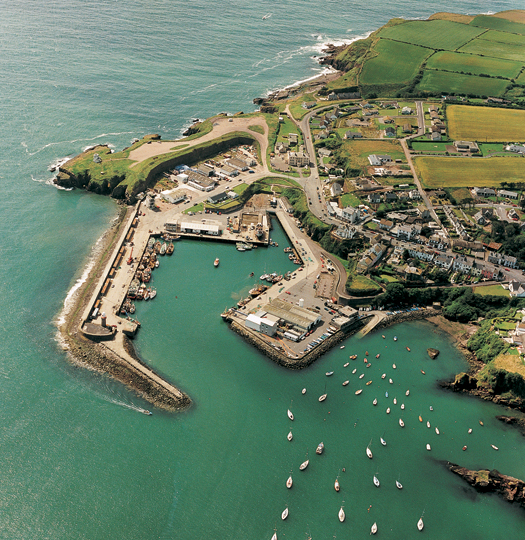
Dunmore East looking south, with Gull Rock lower right hand corner. In a southwesterly breeze, the anchorage is well sheltered, but it can become uncomfortable and even dangerous in southeast to east winds. Photo: Kevin Dwyer
Currently, Dunmore East has probably now slipped beyond fourth place in the Republic of Ireland in terms of fish landings by weight. You get the picture from the 2010 figures by realising that at 163,447 tonnes, Killybegs outstrips all other significant Irish ports combined. Next in line is Castletownbere with 19,030 tonnes, while Dingle is third at 12,761. Although in 2010 Dunmore East was fourth at 8,387 tonnes, in terms of value it was outstripped by Kilmore Quay – Dunmore's landings were worth €13.6m, but Kilmore went for quality, and they got €13.7m for their 3,260 tonnes.
And as Kilmore Quay has more in the way of fish processing plants, the value-added element to their smaller but higher quality catch is also greater than Dunmore East's. In Dunmore East, the continuing encroachment by the needs and expectations of the modern shore-based holiday market means that property is more profitably utilised if it's catering for the personalised needs of the hospitality industry, rather than as an impersonal industrial unit, particularly one with the anti-social aromas of fish processing.
This decline in the fishing industry status of the long-established smaller ports is a European-wide problem, and a new inititative from Brussels seems to offer an opportunity for Dunmore East to be a suitable case for treatment, as interestingly revealed HERE.
Although it all still requires confirmation from the European parliament, many of the EU's maritime nations such as Portugal are quite far down the line in planning projects which will take full advantage of this "post-fishing" scheme, which will involve some quite serious money to be available between 2014 and 2020.
But however obvious the benefits which could accrue to Dunmore East, the rejection by the locals of a major harbour improvement project some years ago (it was to include a marina) has muddied the waters for future projects. The older generation in Dunmore East probably reckon they've accommodated enough change. Though the present layout will seem to today's generations to be a permanent feature of the environment, there are still many around who can well remember the massive re-vamp of the harbour when it was being undertaken by the OPW during the 1960s. It was meant to take about five years, but it took eleven. And at the end of it, the pleasant little cove of Dunmore, sheltered by an elegant pier designed in 1814 by the harbour genius Alexander Nimmo, had been changed greatly, with a breakwater extension going out beyond the pier, while within there was an enormous new concrete apron quay on a site brutally blasted out of pretty cliffs. Despite which, the kittiwake, most unusually nesting on cliffs which had become a central part of the village, had stayed on despite a decade of dynamite.
The kittiwakes may have stayed on, but big fishing is going from Dunmore East. So how best to change the harbour for continuing viability, without destroying the much-loved character of the place, while at the same time profitably accomodating all possible harbour users?

Dunmore East as it will be in the summer of 2013, with the new 40–metre pontoon indicated under the lighthouse on he outer pier. The anchor (top) indicates the anchorage in offshore winds off the Strand Hotel. Plan courtesy Irish Cruising Club
This year will see a small step towards providing berths for visiting cruisers. It's indicated on this latest ICC plan, and will be a 40 metre (120 feet) pontoon running lengthwise along the quay down towards the end of the pier, near the old lighthouse. Access ashore will be via steps that are let into the quay, and it's reckoned that up to twelve boats of average size can be accommodated. Every journey starts with a first step, but this particular first step by its location will require a lot of steps - in fact, route march is more like it - as it's about as far as you can be from the Sailing Club and the village without actually starting to depart from the harbour again.
Welcome as this pontoon is, there's a risk that it might serve as a distraction from more imaginative action, and already there is another quayside pontoon in the southwest corner of the harbour for Dunmore East's many half-deckers. But here at Sailing on Saturdays, we'd suggest that to be of any real value, Dunmore East harbour needs more radical action, and our harbour design department has been busy.
Any modification of Dunmore East harbour for use by craft of all sizes, and mostly smaller than today's average fishing boat, must take account of the fact that, in severe southeasterly gales, the outer parts of the harbour are extremely exposed. Up in the sandy cove off the Strand Hotel, where the ICC sailing directions quite rightly suggest anchoring if the wind is pleasantly between southwest and northwest, it is well known to YouTube viewers that a southeasterly gale (such as occurred on 15th August 2012) can produce impressive onshore breakers going clean over the inn. It's bad enough in a summer storm, and as for winter... in winter – when the traditional fishing season used to be at its height – Dunmore East could fill up with visiting Dutch boats, and after a period of severe southeasters the hotelier at The Strand went up to check his roof, and in the middle of it found a traditional Dutch wooden clog, swept in from the sea and popped up there by a mighty breaking wave.
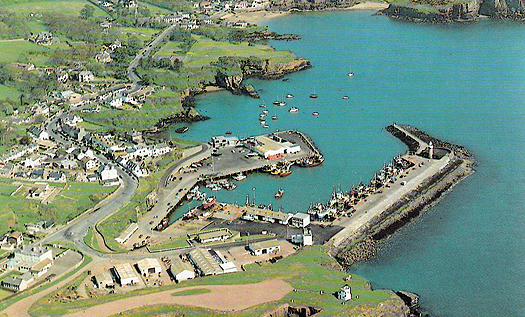
Dunmore East as seen from the southeast, with the Strand Hotel at top of photo. Photo: Rex Roberts
When the Strand Hotel is building up its clog collection in sou'east storms, there's quite a scend which can snake its war round the corner and into the harbour. And of course any yachts lying on the WHSC mooring immediately northwest of the harbour are having a very rugged time indeed. So the suggestion here is that we modify the harbour entrance to keep that scend at bay, and at the same time extend the Gull Rock through the current moorings to provide well sheltered space immediately northwest of the WHSC clubhouse.
The first step in this project would be lengthening the extension to the Outer Pier. Every time you see the place in rough weather, you can't help but think that the engineer in the 1960s would probably have liked to make it twice as long in the first place. But if we're going to have our new breakwater coming along the line of the Gull Rock, in order for it to be long enough to be effective without closing the harbour mouth too much, we have to angle the new outer breakwater extension in a slightly more northerly direction. Not much, but enough to make all the difference to the channel room in the harbour entrance.
The Gull Rock Breakwater is envisaged as being just that – a breakwater. It will have to be about a metre above High Water Springs, otherwise people will try to go over it as they do with the North Bull Wall in Dublin Bay. But the concept is that it's a breakwater and nothing more – no promenade along the top, and preferably made of rock armour to chime with the Gull Rock, though cost may make it necessary to build in tetrapods.

Thinking outside the box – Sailing on Saturday's line of thought for Dunmore East. The new breakwater suggested along the Gull Rock would simply be a breakwater, without a walkway along the top. Drawing by Afloat Studios.
With the extended outer pier and the new Gull Rock breakwater, a well-sheltered area is created for the installation of a marina. That's the beauty of a marina. All it needs is an area of sheltered water with the required depth, and just one single point of shoreside access. There's no need for expensively finished quay walls - a marina is a minimalist installation, and extremely good value once the space has been created.
We appreciate that there will be those who'll be horrified by the thought of any part of that pretty little coastline between the harbour and the Strand Hotel being enclosed behind a breakwater. But we'd emphasise that, as far as possible, the breakwater will be made to seem like a natural extension of the Gull Rock. And while Stony Cove and Badger's Cove will be within the new sheltered space, important locations like Men's Cove (Poul na Leenta) and Lady's Cove will be kept nice and fresh outside.
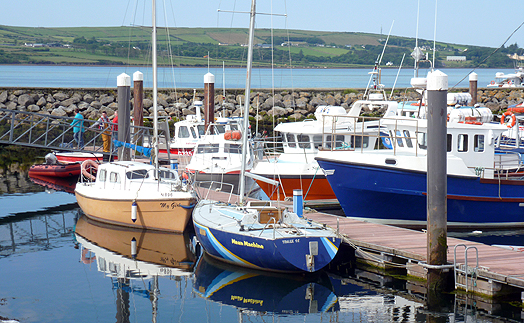
This newer marina for smaller local craft in Dingle suggests a welcome level of co-existence between all types. Photo: W M Nixon
With the marina in place, the entire dock area can revert to being exclusively for fishing boats. But with the industry being rationalized into a more compact shape these days, in time there could well be space for hauling out all boats and other manner of marine work taking place in there. Who knows, but maybe those pontoons running along the quays in the northeast and southwest corners of the harbour – a hugely wasteful use of quay space - might themselves become unofficial little marinas. I found one such in an eastern corner of Dingle Harbour last summer, and it seemed to be working in a harmonious way to accommodate boats of very different type and purpose.
Well, there you have it – it's one idea for Dunmore East, doubtless there are many others. And although Sir Boyle Roche may have quite rightly opined that we should do nothing for posterity on the grounds that posterity have done nothing for us, for the sake of future sailors let us at least take note that the clock in Brussels is ticking, and the train with these new funds will soon be leaving the station.
Comment on this story?
We'd like to hear from you! Leave a message in the box below or email William Nixon directly on [email protected]
WM Nixon's Saturday Sailing blog appears every Saturday on Afloat.ie
Follow us on twitter @afloatmagazine and on our Afloat facebook page
#irishcruising – Henry Ford famously said that if he'd started out by asking people what they wanted, they'd have demanded a faster horse. Quite. But if you don't have the lightbulb moment of a Fordian concept so utterly brilliant that it creates its own market, then a bit of humdrum research to find out what the market wants will seldom go amiss.
Encouraging cruising visitors to sail to our coasts provides a good example. Irish sailing has such a long history of its own that it takes an effort to imagine what sailing visitors to our shores are hoping for. But for cruising visitors in particular, if we have to narrow it down to just one aspiration, we'd probably find that they love to go home with a photo of themselves sailing along with the Fastnet Rock in the background.
Better still, a photo of their boat sailing past the Fastnet on a brisk but sunny day, with themselves at the helm – now that really will hit the spot. And then a video of them celebrating afterwards at some nearby and hospitable port over a convivial seafood feast in a characterful inn, accompanied by traditional music - that will do nicely too.
But it's likely many Irish sailors would no more bother to get themselves that Fastnet photo than New Yorkers would go out of their way to be photographed with the Statue of Liberty. It's an attitude which probably lessens the further away from the famous rock you are based in Ireland. But sailing folk familiar with the coast of West Cork will be well aware that the legendary oceanic submerged mountain is actually less than five miles from the pub on Cape Clear, so where's the big deal? You could easily go round it most days if you wished, so why bother to go round it at all? Even Rockabill off Fingal is further from Joe May's in Skerries than the Fastnet is from North Harbour.
But for visitors, getting that Fastnet money shot is a straightforward, achievable and highly-desired objective. And however much the locals on the Irish coast take it for granted, back home in the big population heartlands of Europe or America or wherever, it's quite a trophy for that neighbourhood sailor recently back from Ireland's rugged seas to have on display.
The magic Fastnet photo is also a popular ambition in that it gives a simple objective to any cruise. As Conor O'Brien observed when he took his old boat Kelpie to go off gun-running with Erskine and Molly Childers on their Asgard in 1914, it's good to have a straightforward objective when you go cruising. But possibly a second significant objective for our cruising visitors is to sail round Ireland, even if many of them find the West Coast so awesome once they get there that they linger on it, and return southward retracing their steps, rather than getting home via the "tame" east coast.
Whatever, I'd reckon that these days Irish boats cruising round Ireland are out-numbered by visitors. For visitors, it's a neat objective, and it has all the attraction of going foreign, whereas a crew on a boat from one of Ireland's main sailing centres will have sailed an almost equally arduous voyage to our Atlantic coasts only to find that, thanks to our excellent new road system, they walk into the pub somewhere like Inishbofin, and find the place is filled with people from their home town who came up to Bofin only that morning.
But whether they're from Ireland or abroad, visitors to Inishbofin and other desirable cruising destinations bring a bit of life to the place, and they spend money too. In these straitened times, it makes sense to find out what they expect in the way of facilities to persuade them to stay on and enjoy themselves, maybe tempting them to visit again. Even better, they might encourage others to do so as well, for it's an irony of this supposed age of impersonal electronic communication that word of mouth seems to work better than ever as a marketing tool.

Cruising sociability – gentle West Cork evening of early summer in Baltimore Photo: W M Nixon
So what will make them happy and keen to come? About a year ago, Failte Ireland commissioned "A Review of Tourism Policy Regarding the Development and Funding of Marina and Berthing Facilities in Ireland". The company given the contract – an English consultancy based in the heart of the Solent area with its massive maritime recreational infrastructure – sensibly recruited a comprehensive expert advisory panel from among people in Ireland in the frontline of providing services to those cruising our coasts. Unlike Henry Ford, they'd at least made a gesture to finding out what people wanted. The result is a 68-page document which was effectively completed in December 2012, but is still embargoed. It awaits publication. The mills of Government truly grind slow, and never more so than at a time when, in any case, there's not a red cent available for expenditure on worthwhile maritime recreation infrastructural projects.
So let us pass the time before its eventual publication with a bit of blue sky thinking about the Irish sailing cruising product, and marketing it. Let's think big, and put broad brush strokes into place. And let's start from basics.
Why do we want to encourage more cruising boats to come to Ireland?
Because they will bring much-needed tourism income, while the presence of cruising yachts sailing along a beautiful coastline enhances the impression it makes as an area of peace and prosperity, with the abundant presence of those boats in popular harbours further reinforcing these positive perceptions, thereby helping to reinforce the entire tourism experience for those ashore and afloat.
What is the experience that people who come here for sailing cruising holidays expect?
Spectacular coastal scenery, good sailing conditions on clean water with decent breezes without being too rough, enough challenge in each day's sailing to give a sense of achievement when a hospitable and entertaining port is reached by evening, and in that port a convenient, welcoming and secure berth for the night among other friendly sailors.
A proper cruising yacht will be fully equipped with her own anchoring system, but if Visitors' Moorings are available they will be used, as the very presence of established moorings will provide the risk of fouling if you drop your own anchor. If a marina or at least a pontoon is available, most visitors will prefer to berth there, as a pontoon berth with shoreside access allows greater freedom of movement for individual crewmembers, who after all have been cramped up together on a confined boat all day.
Dyed-in-the-wool cruising enthusiasts and total boat-lovers may prefer the solitary splendour of lying to a mooring or an anchor. But most folk who are not totally addicted to traditional-style cruising will prefer the individual freedom and convenience provided by a marina berth.

In Dingle, the preferred berth can be found in the marina Photo: W M Nixon
How can we provide the infrastructure to make cruising Ireland for visitors more enjoyable?
There are at least a thousand over-lapping answers to that, but at its most basic the long-established official policy of hoping to have a coastal necklace of marinas every 35 miles still holds good. Obviously that is only the most basic plan – it would need to be varied frequently to fit in with local coastal conditions, population centres, and established harbours – but it provides a structure.
Where do we expect most of our visitors to come from?
While there is a small but significant "Transatlantic trade", most visitors will come from ports in an arc from the northeast to the southeast of Ireland. This includes Scotland, the Isle of Man, Northwest England, Wales, Southwest England, and countries beyond Land's End such as France, Belgium, The Netherlands, and of course the many large sailing centres on the south coast of England.
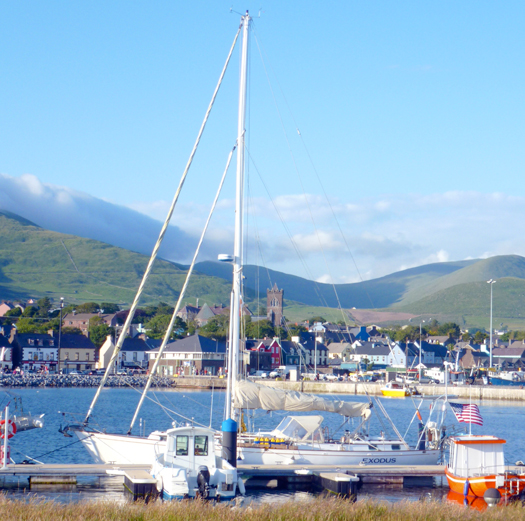
There's a small but significant "Transatlantic trade". The American cutter Exodus was welcomed to Dingle Photo: W M Nixon
The fact of having to round Land's End to get to Ireland for this latter group makes for two distinct visitor streams sailing to this country. The configuration of Ireland's south coast means that any boat rounding Land's End is virtually equidistant from all ports between West Cork and Wexford. With the prevailing winds from the southwest, and the most popular cruising grounds to be found in southwest Ireland, this southern stream will try to make westing as much as possible, preferably to West Cork and certainly no further east than Cork Harbour. They will only shape their course in a more easterly direction if they intend to go northwards through the Irish Sea.
The Bristol Channel makes for the great divide, as most boats in the area are berthed along its north shore, on the south coast of Wales and in Milford Haven. Thus they are part of the other visitor stream. If heading for Ireland, they'll almost invariably make their landfall in south Wexford, and so they will share the needs of people from all ports in the Irish Sea for a better selection of facilities in southeast Ireland, which is the greatest single problem facing the overall development of Ireland's cruising product.
Why is the lack of a good selection of harbours in southeast Ireland such a problem?
There's a large and increasing boat population on both sides of the Irish Sea, and they're keen to go further. While their own area is improving as a cruising ground in its own right, many more of these boats would be attracted to the idea of cruising to Ireland's south and southwest coasts if there were more and better harbours along the coasts in those challenging waters all the way from Arklow to Dungarvan

The big-hearted little port. Despite its small size, Kilmore Quay manages to provide proper berthing for cruisers and a very active fishing fleet.
Photo: W M Nixon
It says everything about the limited facilities in all of southeast Ireland that the provision of a modest marina at Kimore Quay has been the greatest single cruising improvement in the region in fifty years. Kilmore Quay is excellent in its way, it's strategically useful, and is known for the warmth of its welcome. But because it is isolated on an exposed and difficult bit of coast, if you're caught out there in bad weather you've no options for even the most limited movement in reasonably sheltered waters – you just have to stay put and stick it out, or else leave your boat in Kilmore's shelter, and simply go home until the weather improves
By contrast, Dunmore East at the entrance to Waterford Estuary has marvellous natural advantages. Even if the weather is too extreme for offshore passages, there's plenty of sheltered cruising to be had up to Waterford and New Ross, with marinas at both places, while other anchorages are available in attractive surroundings.
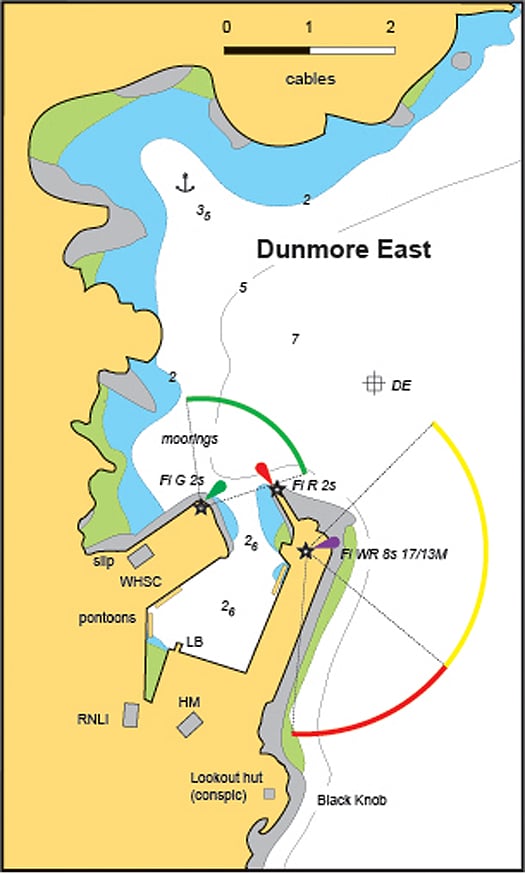
Crowded boats in Dunmore East, which has discouraged cruisers in times past.
Yet despite the friendly Waterford Harbour Sailing Club there doing the best it can in difficult circumstances, the fisheries harbour at Dunmore East has long been noted as actively hostile to cruising boats. It has been a coastal hospitality blackspot on the entire area. The word is that some minor gestures of improvement may be on the way, but as it is, it's difficult to see why it has deteriorated so much, and why positive steps haven't been taken much sooner.
Perhaps it's something to do with the fact that Waterford County Council is headquartered at Dungarvan in the west of the county, while just up the road in the northeast is the all-powerful and historic Waterford City Corporation. Whatever it is, Dunmore East harbour seems to be an administrative orphan. Yet it could be redeemed by being re-invigorated as a fishing port with a significant sailing presence.

Mallaig on Scotland's West Coast used to be a byword for congested and conflicted berthing, but now with a small marina it accommodates cruising boats, fishing boats, a ferry port – and a boatyard too. Photo: W M Nixon
You only have to look at Dingle or Howth to realise that such a thing is perfectly possible. But if the powers that be from the southeast don't want to be seen going to other Irish harbours to see how Dunmore East might be re-born, then let them go to Mallaig on the west coast of Scotland. It used to be a byword for bad tempers, as fishing boats, ferries and cruising yachts battled for space. But now all is sweetness and light with the layout rationalized, and the cruising boats provided with their own neat little 50-berth marina which has made the place not merely somewhere you call by to implement crew changes using the famous west Highland Railway, but an attractive destination in its own right.
So we'll be very interested to see what "A Review of Tourism Policy Regarding the Development and Funding of Marina and Berthing Facilities in Ireland" has to say about Dunmore East. There are times you'd be thinking it's the magic key to the whole thing.
ECHOES OF THE REPUBLIC UP NORTH
Intriguing to see that the Royal Yachting Association's new National Handicap System for cruisers is being launched at Ballyholme YC on Belfast Lough. Is it really so new? After all, most clubs have been getting by with the up-graded Portsmouth Yardstick system for a very long time. And as well, just across the North Channel, the Clyde Yacht Clubs Handicap has been catering for different cruisers for years, and most Belfast Lough boats have been able to avail of that.
But then, things have always been a bit different on Belfast Lough. Back in the late 19th Century, it was a hotbed of pure One Design development, so maybe that tradition has something to do with the lack of a viable local cruiser handicapping system. And by heavens, when they said One Design For Level Racing, they meant it. Having been reared with Belfast Lough sailing, when I first sailed with an alleged One Design class in Dublin, I was amazed to find they ran two sets of results – scratch and handicap. Within the overall class programme, the competition for the handicap prizes was in its way every bit as intense as the straight one design racing.
Thus most boats got a look-in at the prize giving, but in Belfast Lough some never figured at all. Their mood was set by unflinching Calvinists. So in the rare event that one of their One Design fleets ever got above a dozen boats, they'd no hesitation in making the next one Number 13. They wouldn't have dreamt of that in Dublin, where Number 13 simply didn't exist. But I had my very first race aboard the Belfast Lough Waverley Class 18ft Montrose, jointly owned by my father and uncle. And Montrose was Number 13. There are those who would suggest this has affected my life ever since, but they're wrong – touch wood.
Be that as it may, regarding the RYA's claim to novelty for its NHS (I'm sure that won't be the final acronym, with the problems the National Health Service is having across the water these days), at least Mike Urwin of the RORC Measurement Office has made the point that in Ireland we've had a very successful "sundry boats" handicap system running for many years in parallel with the IRC (and the Channel Handicap and the IOR before that), our good and trusty old friend the ECHO system.

The Great ECHO Mother. The unusual lines of the George McGruer-designed 42ft Tritsch-Tratsch, provider of the performance benchmark which facilitated the creation of ECHO back in the early 1970s
It goes right back to 1971, when the late Bill Lacy began to develop a poor man's IOR at Howth by rating local boats on their performance against Otto Glaser's 42ft George McGruer-designed Admirals Cupper Tritsch-Tratsch I. Tritsch Tratsch, a remarkable varnished sloop, was very under-canvassed by today's standards, but a wizard to windward as she had a unique hull based on 12 Metre thinking. Despite her small rig, she could out-sail everything in the area (and elsewhere as well), so she was an excellent benchmark from which the system developed, with Billy working along with Chick Brown, another Howth sailor of mathematical inclinations.
Across in Dun Laoghaire, Hal Sisk and Ernest Goulding had been working on something similar, and an area handicap system developed so successfully that it was given the grand title of East Coast Handicap Organisation, though those involved readily admitted that if anything, ECHO stood for Ernest, Chick, Hal and Others.
Whatever, it worked, rating crews and helms as much as boats. It was a system which was readily accepted in an area where One Design Classes readily allocated different performance figures, and in a country where the Golfing Union of Ireland had led the world in handicapping individual players. As for those of us who felt our modest successes had been allowed to raise our handicaps too much, we could always take our boats and get them weighed and measured for a rating from the more impersonal Channel Handicap System.
So now, 42 years after Bill Lacy and his friends started their ground-breaking system, they're hearing about something similar up north. One trusts that they're aware that not only is today the 13th of the month, but we're also in the year of superstition 2013.
As for Tritsch-Tratsch the Great Echo Mother, the last I heard of her she was in Maine, with an owner who cherishes slightly eccentric classic boats. She is that and more. But what a performer to windward.....back in 1972 she was slugging upwind on a very windy but sunny Sunday morning out in the middle of the Irish Sea, rocketing along and making mincemeat of the steep breaking seas in an ISORA race, with the rest of the fleet way behind.
A big ship hove into view, and paced along beside her, both of them covered in spray and spume, and the noise intense. Suddenly, it occurred to TT's crew that the ship might think they needed help. So they called her on the VHF, and told them on the bridge that everything was okay. Their reply would have gladdened any owner's heart:
"We can see that," said the ship. "But it's just that your boat is going great. Absolutely marvellous. D'you mind if we watch for a while?"


